Introduction to Finance
VerifiedAdded on 2022/11/11
|19
|4004
|281
AI Summary
This document provides an introduction to finance and covers topics such as initial investment, net operating cash flows, NPV, IRR, sensitivity analysis, and more. It includes tables and calculations for each topic. Additionally, it provides an overview of leasing versus purchasing a coffee machine and analyzes internal and external risk factors. The document is suitable for students studying finance and related subjects.
Contribute Materials
Your contribution can guide someone’s learning journey. Share your
documents today.

Introduction to Finance
Secure Best Marks with AI Grader
Need help grading? Try our AI Grader for instant feedback on your assignments.
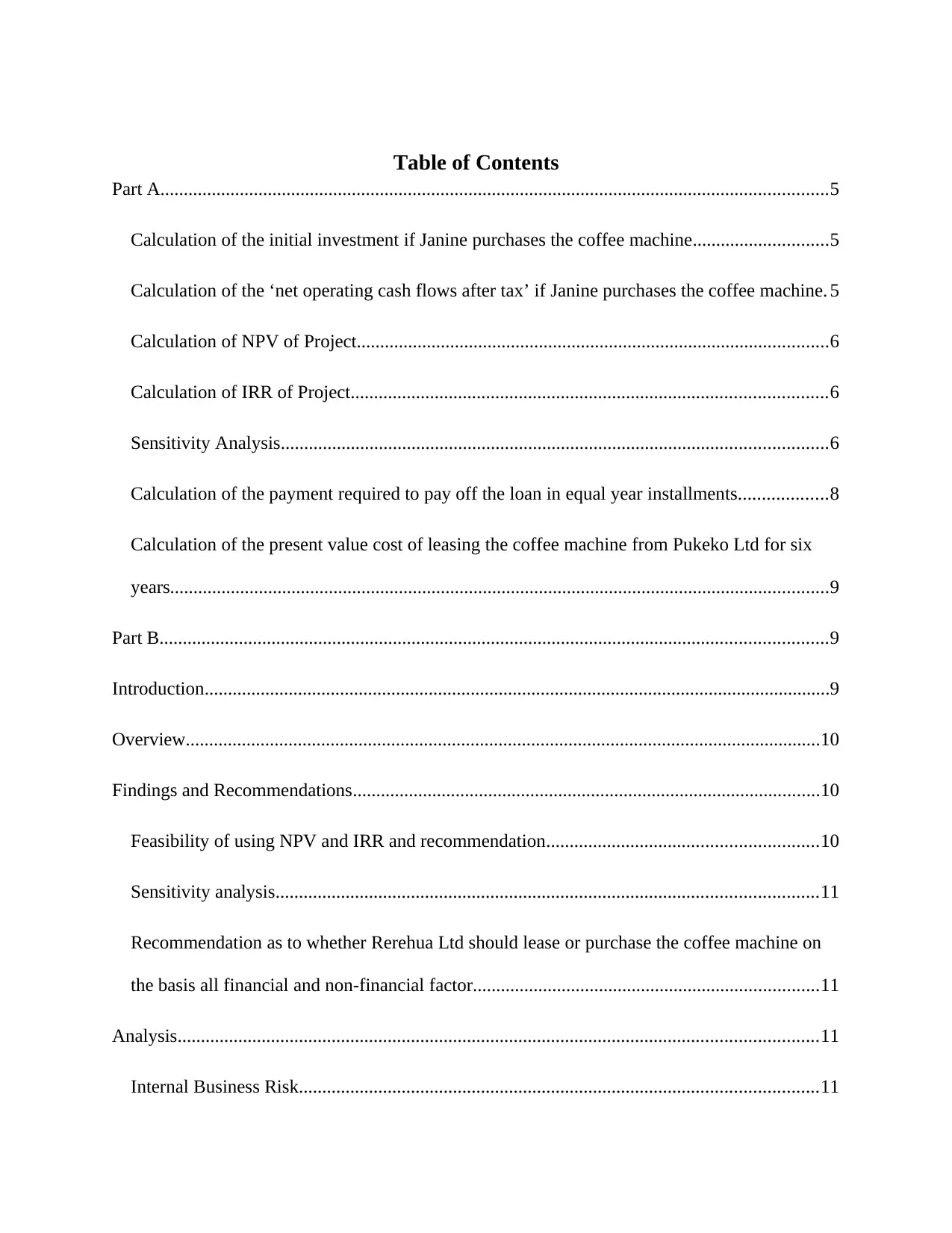
Table of Contents
Part A...............................................................................................................................................5
Calculation of the initial investment if Janine purchases the coffee machine.............................5
Calculation of the ‘net operating cash flows after tax’ if Janine purchases the coffee machine. 5
Calculation of NPV of Project.....................................................................................................6
Calculation of IRR of Project......................................................................................................6
Sensitivity Analysis.....................................................................................................................6
Calculation of the payment required to pay off the loan in equal year installments...................8
Calculation of the present value cost of leasing the coffee machine from Pukeko Ltd for six
years.............................................................................................................................................9
Part B...............................................................................................................................................9
Introduction......................................................................................................................................9
Overview........................................................................................................................................10
Findings and Recommendations....................................................................................................10
Feasibility of using NPV and IRR and recommendation..........................................................10
Sensitivity analysis....................................................................................................................11
Recommendation as to whether Rerehua Ltd should lease or purchase the coffee machine on
the basis all financial and non-financial factor..........................................................................11
Analysis.........................................................................................................................................11
Internal Business Risk...............................................................................................................11
Part A...............................................................................................................................................5
Calculation of the initial investment if Janine purchases the coffee machine.............................5
Calculation of the ‘net operating cash flows after tax’ if Janine purchases the coffee machine. 5
Calculation of NPV of Project.....................................................................................................6
Calculation of IRR of Project......................................................................................................6
Sensitivity Analysis.....................................................................................................................6
Calculation of the payment required to pay off the loan in equal year installments...................8
Calculation of the present value cost of leasing the coffee machine from Pukeko Ltd for six
years.............................................................................................................................................9
Part B...............................................................................................................................................9
Introduction......................................................................................................................................9
Overview........................................................................................................................................10
Findings and Recommendations....................................................................................................10
Feasibility of using NPV and IRR and recommendation..........................................................10
Sensitivity analysis....................................................................................................................11
Recommendation as to whether Rerehua Ltd should lease or purchase the coffee machine on
the basis all financial and non-financial factor..........................................................................11
Analysis.........................................................................................................................................11
Internal Business Risk...............................................................................................................11
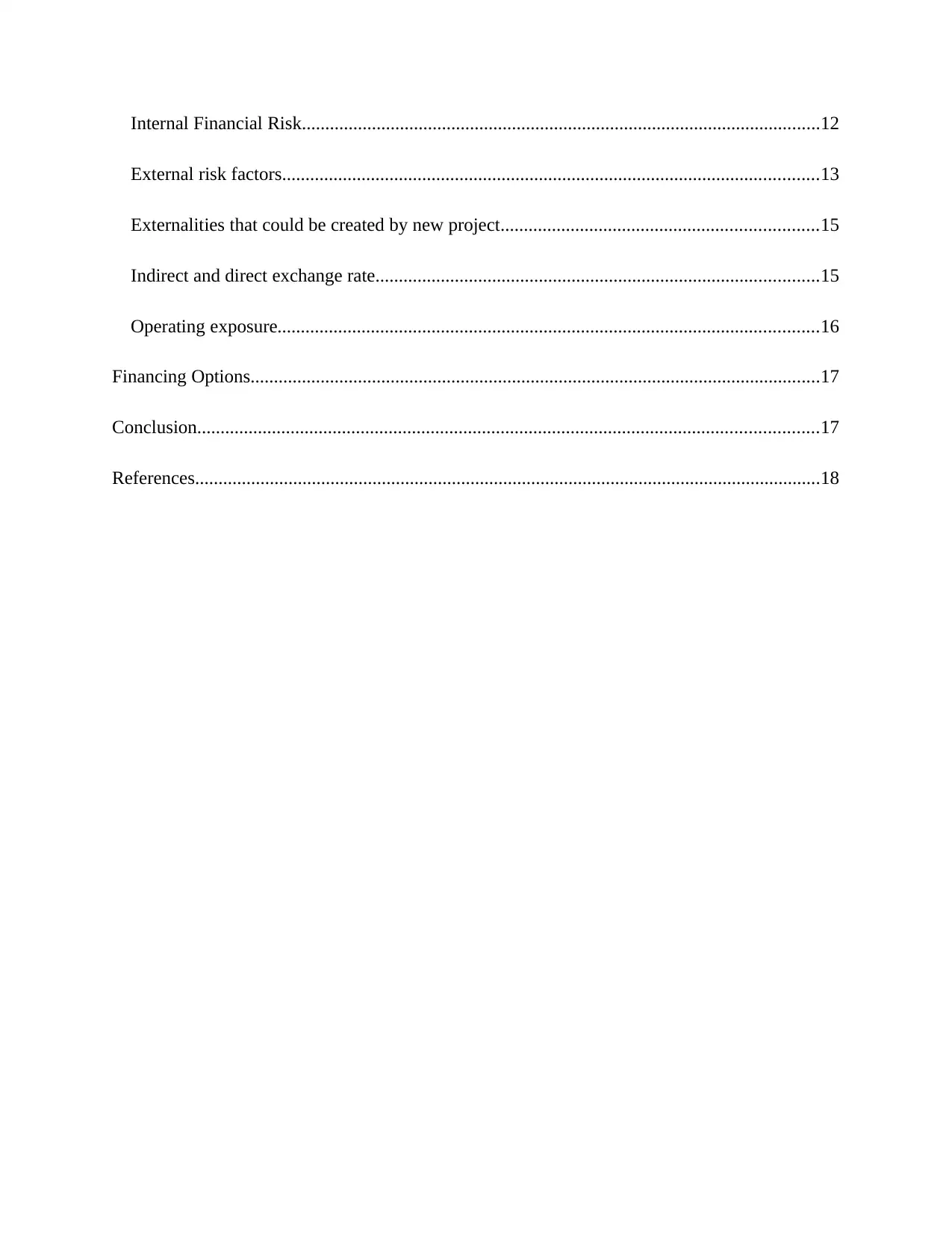
Internal Financial Risk...............................................................................................................12
External risk factors...................................................................................................................13
Externalities that could be created by new project....................................................................15
Indirect and direct exchange rate...............................................................................................15
Operating exposure....................................................................................................................16
Financing Options..........................................................................................................................17
Conclusion.....................................................................................................................................17
References......................................................................................................................................18
External risk factors...................................................................................................................13
Externalities that could be created by new project....................................................................15
Indirect and direct exchange rate...............................................................................................15
Operating exposure....................................................................................................................16
Financing Options..........................................................................................................................17
Conclusion.....................................................................................................................................17
References......................................................................................................................................18
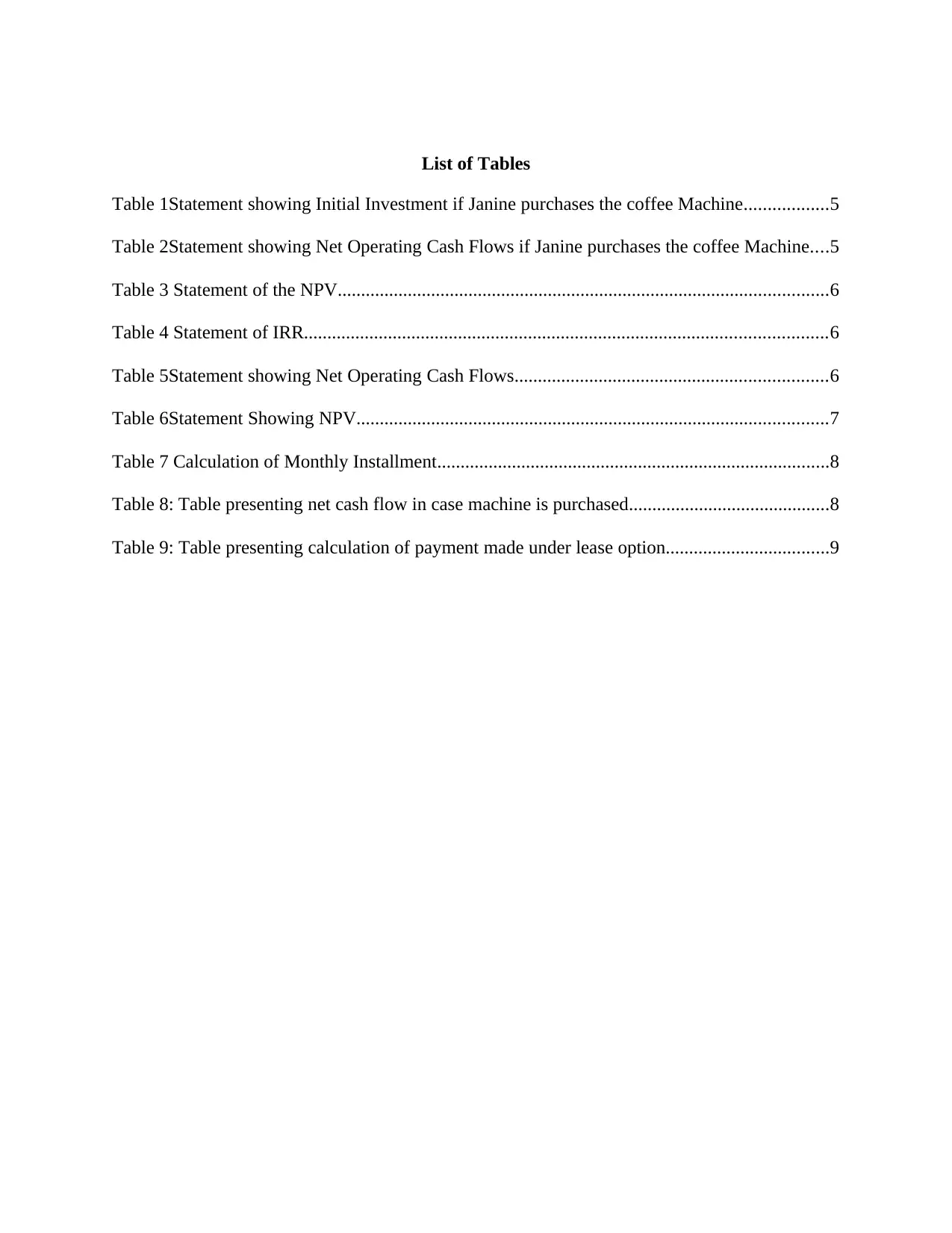
List of Tables
Table 1Statement showing Initial Investment if Janine purchases the coffee Machine..................5
Table 2Statement showing Net Operating Cash Flows if Janine purchases the coffee Machine....5
Table 3 Statement of the NPV.........................................................................................................6
Table 4 Statement of IRR................................................................................................................6
Table 5Statement showing Net Operating Cash Flows...................................................................6
Table 6Statement Showing NPV.....................................................................................................7
Table 7 Calculation of Monthly Installment....................................................................................8
Table 8: Table presenting net cash flow in case machine is purchased...........................................8
Table 9: Table presenting calculation of payment made under lease option...................................9
Table 1Statement showing Initial Investment if Janine purchases the coffee Machine..................5
Table 2Statement showing Net Operating Cash Flows if Janine purchases the coffee Machine....5
Table 3 Statement of the NPV.........................................................................................................6
Table 4 Statement of IRR................................................................................................................6
Table 5Statement showing Net Operating Cash Flows...................................................................6
Table 6Statement Showing NPV.....................................................................................................7
Table 7 Calculation of Monthly Installment....................................................................................8
Table 8: Table presenting net cash flow in case machine is purchased...........................................8
Table 9: Table presenting calculation of payment made under lease option...................................9
Secure Best Marks with AI Grader
Need help grading? Try our AI Grader for instant feedback on your assignments.
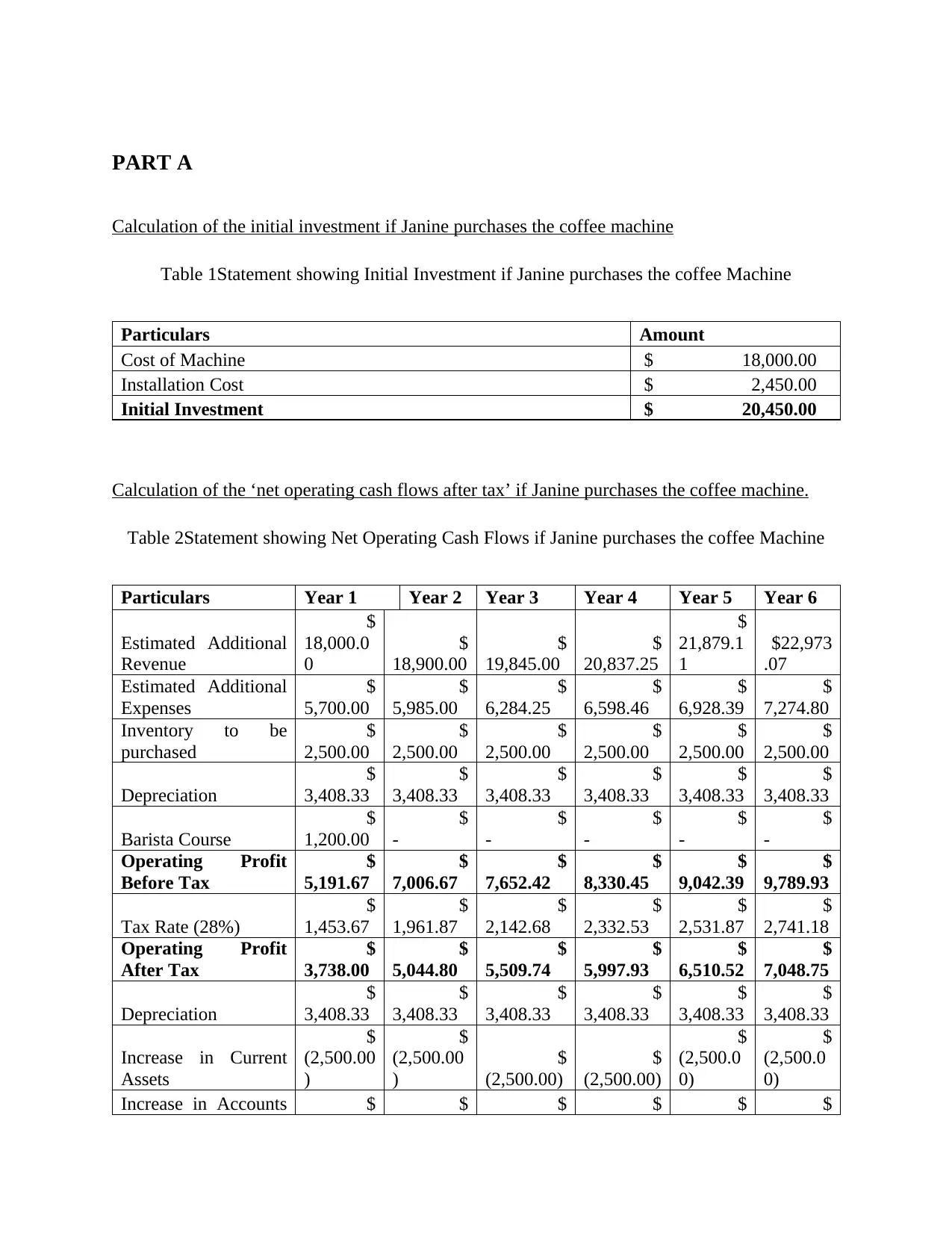
PART A
Calculation of the initial investment if Janine purchases the coffee machine
Table 1Statement showing Initial Investment if Janine purchases the coffee Machine
Particulars Amount
Cost of Machine $ 18,000.00
Installation Cost $ 2,450.00
Initial Investment $ 20,450.00
Calculation of the ‘net operating cash flows after tax’ if Janine purchases the coffee machine.
Table 2Statement showing Net Operating Cash Flows if Janine purchases the coffee Machine
Particulars Year 1 Year 2 Year 3 Year 4 Year 5 Year 6
Estimated Additional
Revenue
$
18,000.0
0
$
18,900.00
$
19,845.00
$
20,837.25
$
21,879.1
1
$22,973
.07
Estimated Additional
Expenses
$
5,700.00
$
5,985.00
$
6,284.25
$
6,598.46
$
6,928.39
$
7,274.80
Inventory to be
purchased
$
2,500.00
$
2,500.00
$
2,500.00
$
2,500.00
$
2,500.00
$
2,500.00
Depreciation
$
3,408.33
$
3,408.33
$
3,408.33
$
3,408.33
$
3,408.33
$
3,408.33
Barista Course
$
1,200.00
$
-
$
-
$
-
$
-
$
-
Operating Profit
Before Tax
$
5,191.67
$
7,006.67
$
7,652.42
$
8,330.45
$
9,042.39
$
9,789.93
Tax Rate (28%)
$
1,453.67
$
1,961.87
$
2,142.68
$
2,332.53
$
2,531.87
$
2,741.18
Operating Profit
After Tax
$
3,738.00
$
5,044.80
$
5,509.74
$
5,997.93
$
6,510.52
$
7,048.75
Depreciation
$
3,408.33
$
3,408.33
$
3,408.33
$
3,408.33
$
3,408.33
$
3,408.33
Increase in Current
Assets
$
(2,500.00
)
$
(2,500.00
)
$
(2,500.00)
$
(2,500.00)
$
(2,500.0
0)
$
(2,500.0
0)
Increase in Accounts $ $ $ $ $ $
Calculation of the initial investment if Janine purchases the coffee machine
Table 1Statement showing Initial Investment if Janine purchases the coffee Machine
Particulars Amount
Cost of Machine $ 18,000.00
Installation Cost $ 2,450.00
Initial Investment $ 20,450.00
Calculation of the ‘net operating cash flows after tax’ if Janine purchases the coffee machine.
Table 2Statement showing Net Operating Cash Flows if Janine purchases the coffee Machine
Particulars Year 1 Year 2 Year 3 Year 4 Year 5 Year 6
Estimated Additional
Revenue
$
18,000.0
0
$
18,900.00
$
19,845.00
$
20,837.25
$
21,879.1
1
$22,973
.07
Estimated Additional
Expenses
$
5,700.00
$
5,985.00
$
6,284.25
$
6,598.46
$
6,928.39
$
7,274.80
Inventory to be
purchased
$
2,500.00
$
2,500.00
$
2,500.00
$
2,500.00
$
2,500.00
$
2,500.00
Depreciation
$
3,408.33
$
3,408.33
$
3,408.33
$
3,408.33
$
3,408.33
$
3,408.33
Barista Course
$
1,200.00
$
-
$
-
$
-
$
-
$
-
Operating Profit
Before Tax
$
5,191.67
$
7,006.67
$
7,652.42
$
8,330.45
$
9,042.39
$
9,789.93
Tax Rate (28%)
$
1,453.67
$
1,961.87
$
2,142.68
$
2,332.53
$
2,531.87
$
2,741.18
Operating Profit
After Tax
$
3,738.00
$
5,044.80
$
5,509.74
$
5,997.93
$
6,510.52
$
7,048.75
Depreciation
$
3,408.33
$
3,408.33
$
3,408.33
$
3,408.33
$
3,408.33
$
3,408.33
Increase in Current
Assets
$
(2,500.00
)
$
(2,500.00
)
$
(2,500.00)
$
(2,500.00)
$
(2,500.0
0)
$
(2,500.0
0)
Increase in Accounts $ $ $ $ $ $
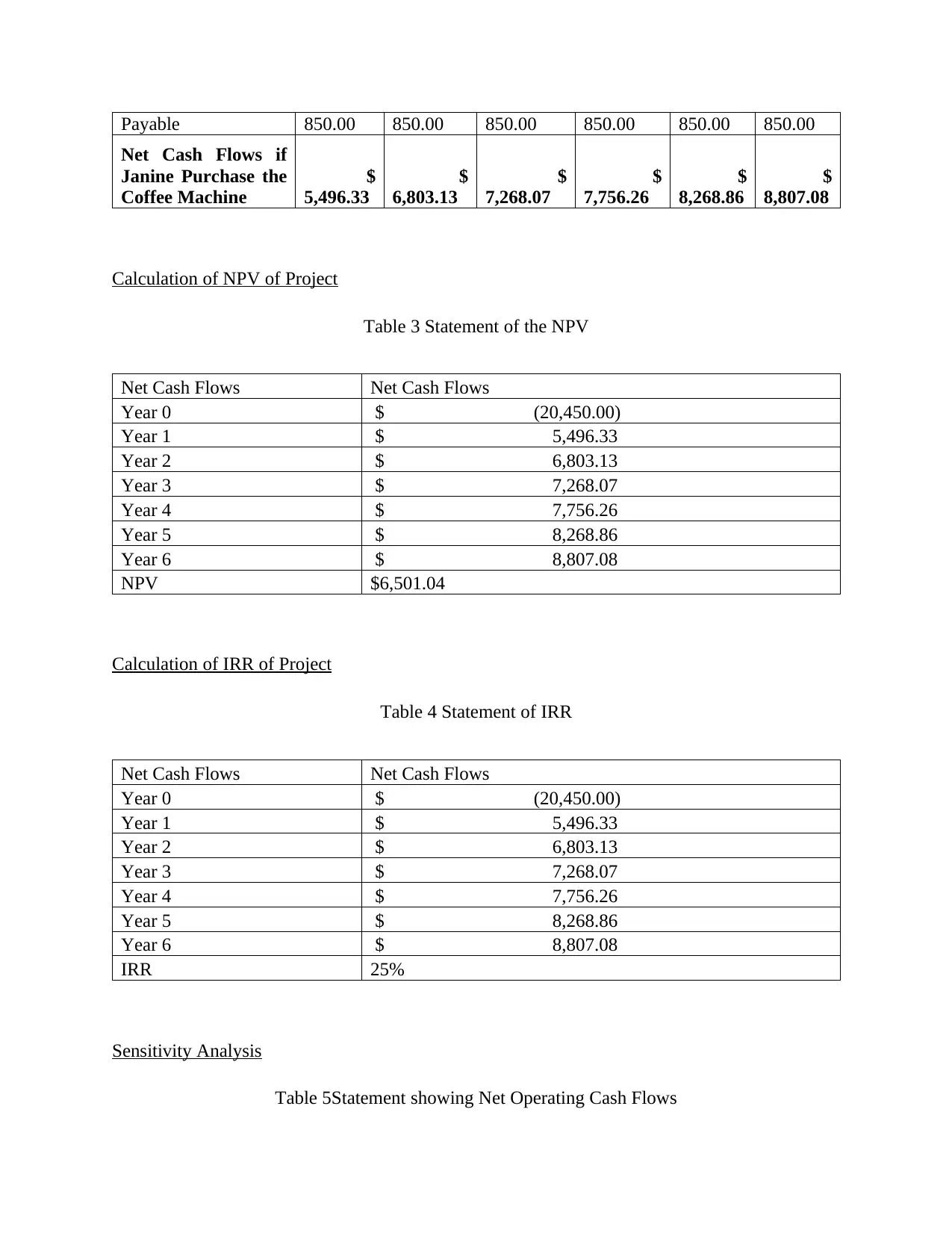
Payable 850.00 850.00 850.00 850.00 850.00 850.00
Net Cash Flows if
Janine Purchase the
Coffee Machine
$
5,496.33
$
6,803.13
$
7,268.07
$
7,756.26
$
8,268.86
$
8,807.08
Calculation of NPV of Project
Table 3 Statement of the NPV
Net Cash Flows Net Cash Flows
Year 0 $ (20,450.00)
Year 1 $ 5,496.33
Year 2 $ 6,803.13
Year 3 $ 7,268.07
Year 4 $ 7,756.26
Year 5 $ 8,268.86
Year 6 $ 8,807.08
NPV $6,501.04
Calculation of IRR of Project
Table 4 Statement of IRR
Net Cash Flows Net Cash Flows
Year 0 $ (20,450.00)
Year 1 $ 5,496.33
Year 2 $ 6,803.13
Year 3 $ 7,268.07
Year 4 $ 7,756.26
Year 5 $ 8,268.86
Year 6 $ 8,807.08
IRR 25%
Sensitivity Analysis
Table 5Statement showing Net Operating Cash Flows
Net Cash Flows if
Janine Purchase the
Coffee Machine
$
5,496.33
$
6,803.13
$
7,268.07
$
7,756.26
$
8,268.86
$
8,807.08
Calculation of NPV of Project
Table 3 Statement of the NPV
Net Cash Flows Net Cash Flows
Year 0 $ (20,450.00)
Year 1 $ 5,496.33
Year 2 $ 6,803.13
Year 3 $ 7,268.07
Year 4 $ 7,756.26
Year 5 $ 8,268.86
Year 6 $ 8,807.08
NPV $6,501.04
Calculation of IRR of Project
Table 4 Statement of IRR
Net Cash Flows Net Cash Flows
Year 0 $ (20,450.00)
Year 1 $ 5,496.33
Year 2 $ 6,803.13
Year 3 $ 7,268.07
Year 4 $ 7,756.26
Year 5 $ 8,268.86
Year 6 $ 8,807.08
IRR 25%
Sensitivity Analysis
Table 5Statement showing Net Operating Cash Flows
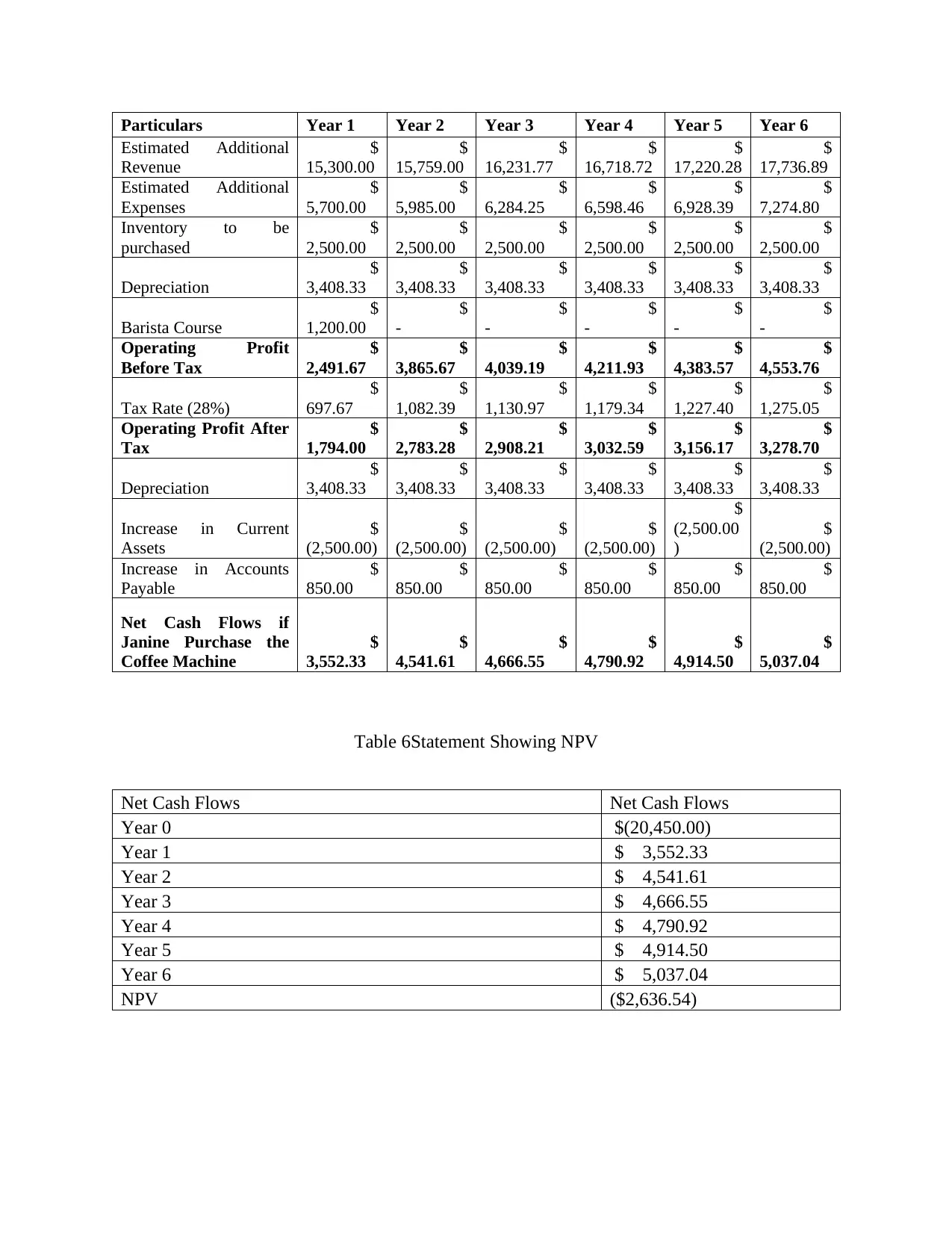
Particulars Year 1 Year 2 Year 3 Year 4 Year 5 Year 6
Estimated Additional
Revenue
$
15,300.00
$
15,759.00
$
16,231.77
$
16,718.72
$
17,220.28
$
17,736.89
Estimated Additional
Expenses
$
5,700.00
$
5,985.00
$
6,284.25
$
6,598.46
$
6,928.39
$
7,274.80
Inventory to be
purchased
$
2,500.00
$
2,500.00
$
2,500.00
$
2,500.00
$
2,500.00
$
2,500.00
Depreciation
$
3,408.33
$
3,408.33
$
3,408.33
$
3,408.33
$
3,408.33
$
3,408.33
Barista Course
$
1,200.00
$
-
$
-
$
-
$
-
$
-
Operating Profit
Before Tax
$
2,491.67
$
3,865.67
$
4,039.19
$
4,211.93
$
4,383.57
$
4,553.76
Tax Rate (28%)
$
697.67
$
1,082.39
$
1,130.97
$
1,179.34
$
1,227.40
$
1,275.05
Operating Profit After
Tax
$
1,794.00
$
2,783.28
$
2,908.21
$
3,032.59
$
3,156.17
$
3,278.70
Depreciation
$
3,408.33
$
3,408.33
$
3,408.33
$
3,408.33
$
3,408.33
$
3,408.33
Increase in Current
Assets
$
(2,500.00)
$
(2,500.00)
$
(2,500.00)
$
(2,500.00)
$
(2,500.00
)
$
(2,500.00)
Increase in Accounts
Payable
$
850.00
$
850.00
$
850.00
$
850.00
$
850.00
$
850.00
Net Cash Flows if
Janine Purchase the
Coffee Machine
$
3,552.33
$
4,541.61
$
4,666.55
$
4,790.92
$
4,914.50
$
5,037.04
Table 6Statement Showing NPV
Net Cash Flows Net Cash Flows
Year 0 $(20,450.00)
Year 1 $ 3,552.33
Year 2 $ 4,541.61
Year 3 $ 4,666.55
Year 4 $ 4,790.92
Year 5 $ 4,914.50
Year 6 $ 5,037.04
NPV ($2,636.54)
Estimated Additional
Revenue
$
15,300.00
$
15,759.00
$
16,231.77
$
16,718.72
$
17,220.28
$
17,736.89
Estimated Additional
Expenses
$
5,700.00
$
5,985.00
$
6,284.25
$
6,598.46
$
6,928.39
$
7,274.80
Inventory to be
purchased
$
2,500.00
$
2,500.00
$
2,500.00
$
2,500.00
$
2,500.00
$
2,500.00
Depreciation
$
3,408.33
$
3,408.33
$
3,408.33
$
3,408.33
$
3,408.33
$
3,408.33
Barista Course
$
1,200.00
$
-
$
-
$
-
$
-
$
-
Operating Profit
Before Tax
$
2,491.67
$
3,865.67
$
4,039.19
$
4,211.93
$
4,383.57
$
4,553.76
Tax Rate (28%)
$
697.67
$
1,082.39
$
1,130.97
$
1,179.34
$
1,227.40
$
1,275.05
Operating Profit After
Tax
$
1,794.00
$
2,783.28
$
2,908.21
$
3,032.59
$
3,156.17
$
3,278.70
Depreciation
$
3,408.33
$
3,408.33
$
3,408.33
$
3,408.33
$
3,408.33
$
3,408.33
Increase in Current
Assets
$
(2,500.00)
$
(2,500.00)
$
(2,500.00)
$
(2,500.00)
$
(2,500.00
)
$
(2,500.00)
Increase in Accounts
Payable
$
850.00
$
850.00
$
850.00
$
850.00
$
850.00
$
850.00
Net Cash Flows if
Janine Purchase the
Coffee Machine
$
3,552.33
$
4,541.61
$
4,666.55
$
4,790.92
$
4,914.50
$
5,037.04
Table 6Statement Showing NPV
Net Cash Flows Net Cash Flows
Year 0 $(20,450.00)
Year 1 $ 3,552.33
Year 2 $ 4,541.61
Year 3 $ 4,666.55
Year 4 $ 4,790.92
Year 5 $ 4,914.50
Year 6 $ 5,037.04
NPV ($2,636.54)
Paraphrase This Document
Need a fresh take? Get an instant paraphrase of this document with our AI Paraphraser
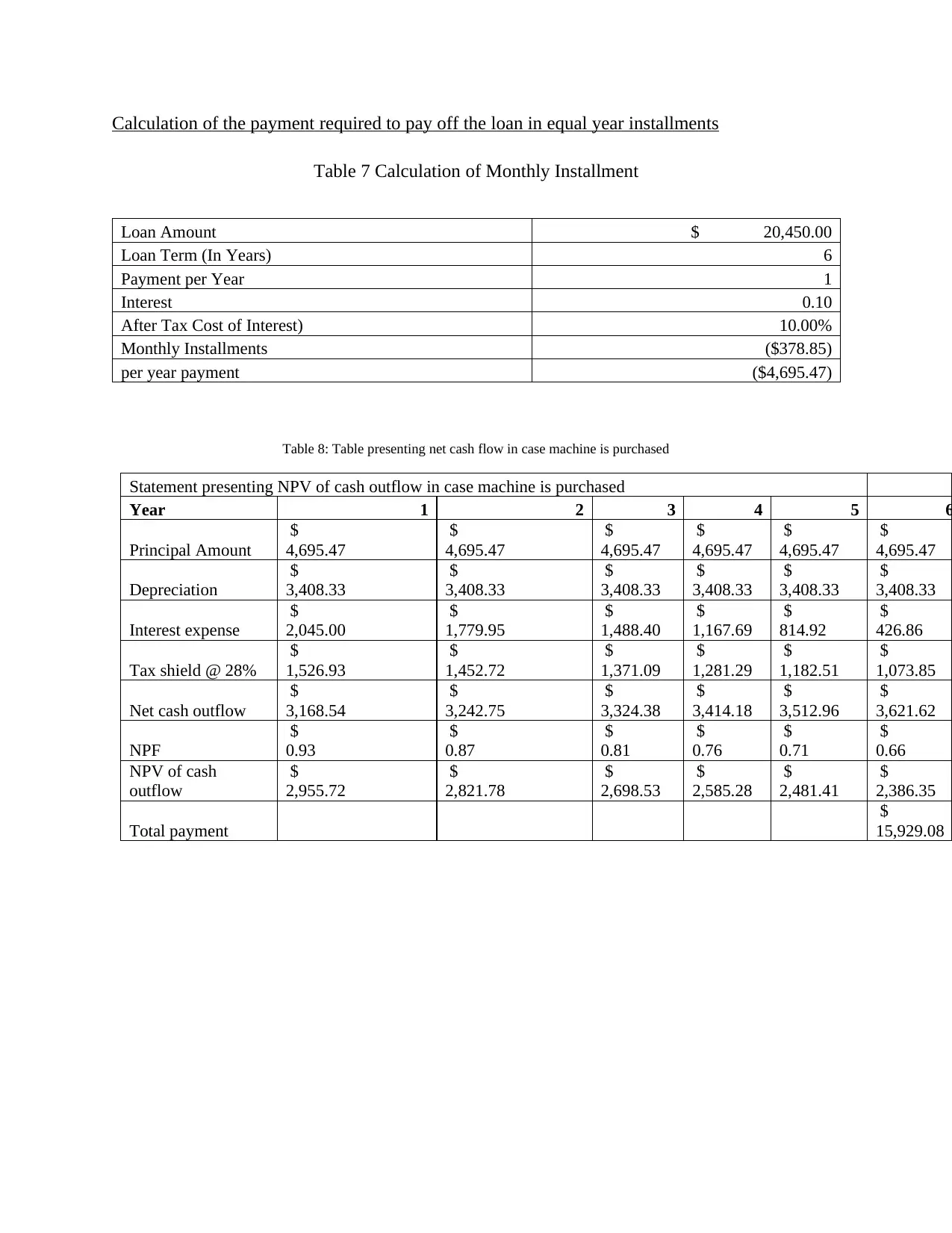
Calculation of the payment required to pay off the loan in equal year installments
Table 7 Calculation of Monthly Installment
Loan Amount $ 20,450.00
Loan Term (In Years) 6
Payment per Year 1
Interest 0.10
After Tax Cost of Interest) 10.00%
Monthly Installments ($378.85)
per year payment ($4,695.47)
Table 8: Table presenting net cash flow in case machine is purchased
Statement presenting NPV of cash outflow in case machine is purchased
Year 1 2 3 4 5 6
Principal Amount
$
4,695.47
$
4,695.47
$
4,695.47
$
4,695.47
$
4,695.47
$
4,695.47
Depreciation
$
3,408.33
$
3,408.33
$
3,408.33
$
3,408.33
$
3,408.33
$
3,408.33
Interest expense
$
2,045.00
$
1,779.95
$
1,488.40
$
1,167.69
$
814.92
$
426.86
Tax shield @ 28%
$
1,526.93
$
1,452.72
$
1,371.09
$
1,281.29
$
1,182.51
$
1,073.85
Net cash outflow
$
3,168.54
$
3,242.75
$
3,324.38
$
3,414.18
$
3,512.96
$
3,621.62
NPF
$
0.93
$
0.87
$
0.81
$
0.76
$
0.71
$
0.66
NPV of cash
outflow
$
2,955.72
$
2,821.78
$
2,698.53
$
2,585.28
$
2,481.41
$
2,386.35
Total payment
$
15,929.08
Table 7 Calculation of Monthly Installment
Loan Amount $ 20,450.00
Loan Term (In Years) 6
Payment per Year 1
Interest 0.10
After Tax Cost of Interest) 10.00%
Monthly Installments ($378.85)
per year payment ($4,695.47)
Table 8: Table presenting net cash flow in case machine is purchased
Statement presenting NPV of cash outflow in case machine is purchased
Year 1 2 3 4 5 6
Principal Amount
$
4,695.47
$
4,695.47
$
4,695.47
$
4,695.47
$
4,695.47
$
4,695.47
Depreciation
$
3,408.33
$
3,408.33
$
3,408.33
$
3,408.33
$
3,408.33
$
3,408.33
Interest expense
$
2,045.00
$
1,779.95
$
1,488.40
$
1,167.69
$
814.92
$
426.86
Tax shield @ 28%
$
1,526.93
$
1,452.72
$
1,371.09
$
1,281.29
$
1,182.51
$
1,073.85
Net cash outflow
$
3,168.54
$
3,242.75
$
3,324.38
$
3,414.18
$
3,512.96
$
3,621.62
NPF
$
0.93
$
0.87
$
0.81
$
0.76
$
0.71
$
0.66
NPV of cash
outflow
$
2,955.72
$
2,821.78
$
2,698.53
$
2,585.28
$
2,481.41
$
2,386.35
Total payment
$
15,929.08
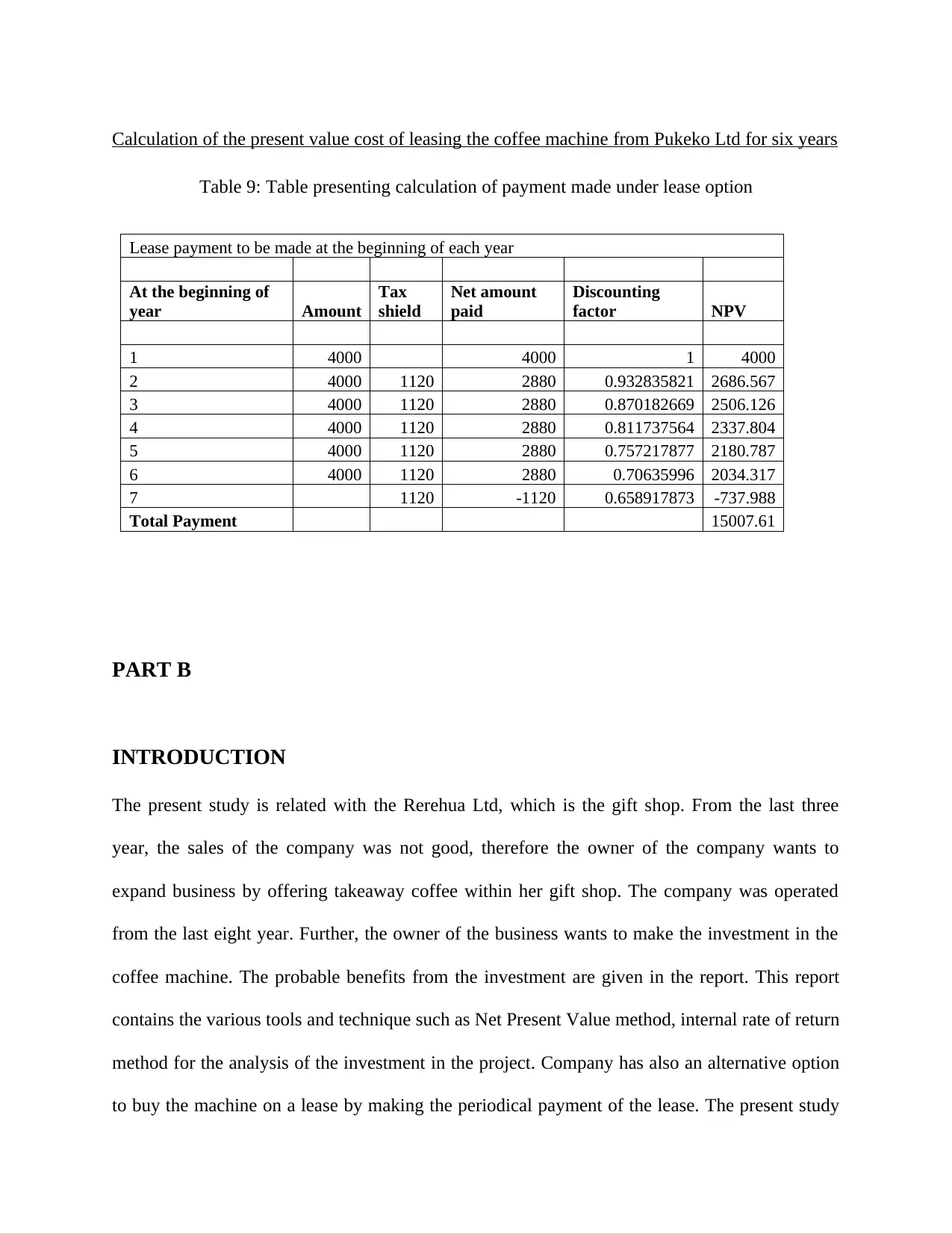
Calculation of the present value cost of leasing the coffee machine from Pukeko Ltd for six years
Table 9: Table presenting calculation of payment made under lease option
Lease payment to be made at the beginning of each year
At the beginning of
year Amount
Tax
shield
Net amount
paid
Discounting
factor NPV
1 4000 4000 1 4000
2 4000 1120 2880 0.932835821 2686.567
3 4000 1120 2880 0.870182669 2506.126
4 4000 1120 2880 0.811737564 2337.804
5 4000 1120 2880 0.757217877 2180.787
6 4000 1120 2880 0.70635996 2034.317
7 1120 -1120 0.658917873 -737.988
Total Payment 15007.61
PART B
INTRODUCTION
The present study is related with the Rerehua Ltd, which is the gift shop. From the last three
year, the sales of the company was not good, therefore the owner of the company wants to
expand business by offering takeaway coffee within her gift shop. The company was operated
from the last eight year. Further, the owner of the business wants to make the investment in the
coffee machine. The probable benefits from the investment are given in the report. This report
contains the various tools and technique such as Net Present Value method, internal rate of return
method for the analysis of the investment in the project. Company has also an alternative option
to buy the machine on a lease by making the periodical payment of the lease. The present study
Table 9: Table presenting calculation of payment made under lease option
Lease payment to be made at the beginning of each year
At the beginning of
year Amount
Tax
shield
Net amount
paid
Discounting
factor NPV
1 4000 4000 1 4000
2 4000 1120 2880 0.932835821 2686.567
3 4000 1120 2880 0.870182669 2506.126
4 4000 1120 2880 0.811737564 2337.804
5 4000 1120 2880 0.757217877 2180.787
6 4000 1120 2880 0.70635996 2034.317
7 1120 -1120 0.658917873 -737.988
Total Payment 15007.61
PART B
INTRODUCTION
The present study is related with the Rerehua Ltd, which is the gift shop. From the last three
year, the sales of the company was not good, therefore the owner of the company wants to
expand business by offering takeaway coffee within her gift shop. The company was operated
from the last eight year. Further, the owner of the business wants to make the investment in the
coffee machine. The probable benefits from the investment are given in the report. This report
contains the various tools and technique such as Net Present Value method, internal rate of return
method for the analysis of the investment in the project. Company has also an alternative option
to buy the machine on a lease by making the periodical payment of the lease. The present study
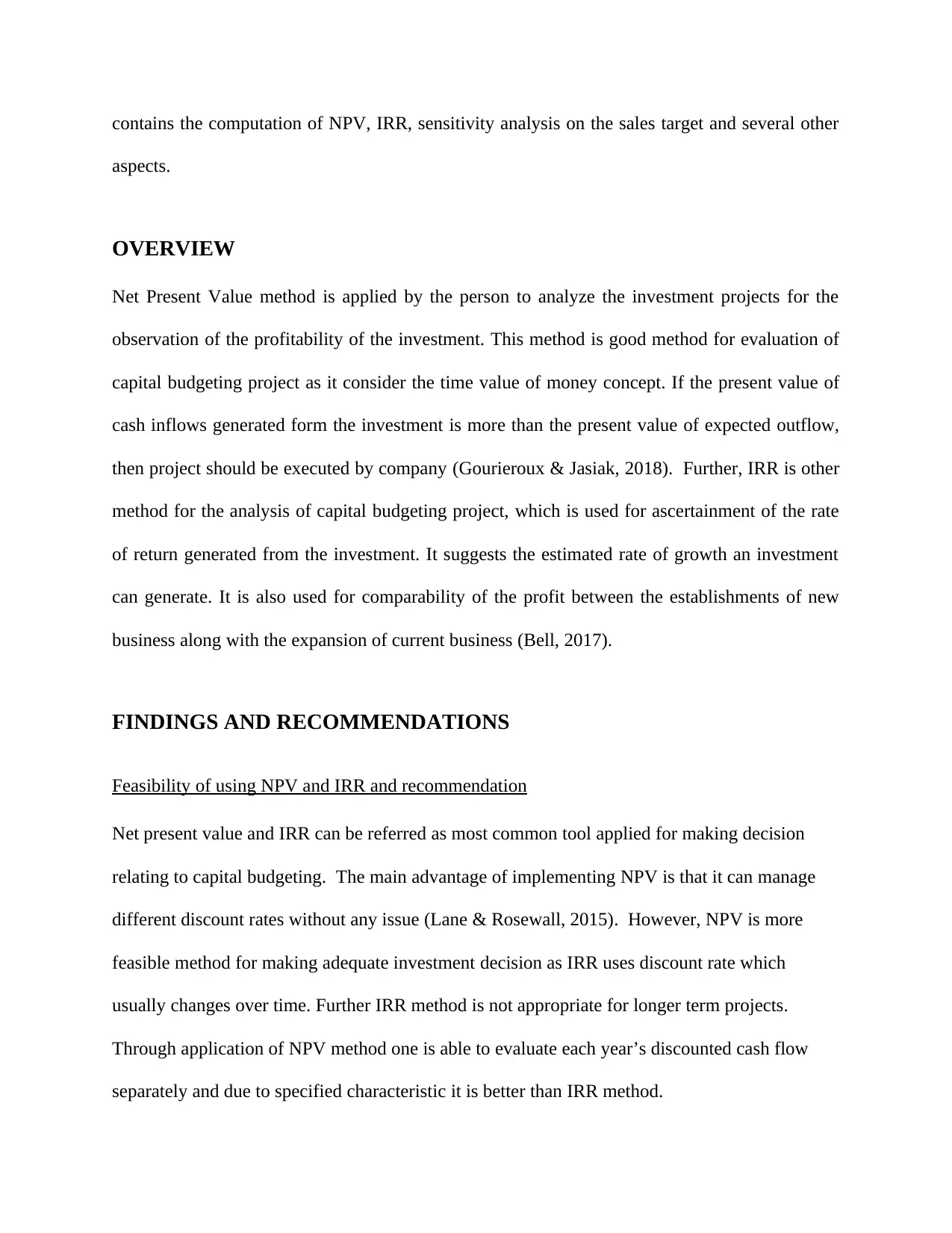
contains the computation of NPV, IRR, sensitivity analysis on the sales target and several other
aspects.
OVERVIEW
Net Present Value method is applied by the person to analyze the investment projects for the
observation of the profitability of the investment. This method is good method for evaluation of
capital budgeting project as it consider the time value of money concept. If the present value of
cash inflows generated form the investment is more than the present value of expected outflow,
then project should be executed by company (Gourieroux & Jasiak, 2018). Further, IRR is other
method for the analysis of capital budgeting project, which is used for ascertainment of the rate
of return generated from the investment. It suggests the estimated rate of growth an investment
can generate. It is also used for comparability of the profit between the establishments of new
business along with the expansion of current business (Bell, 2017).
FINDINGS AND RECOMMENDATIONS
Feasibility of using NPV and IRR and recommendation
Net present value and IRR can be referred as most common tool applied for making decision
relating to capital budgeting. The main advantage of implementing NPV is that it can manage
different discount rates without any issue (Lane & Rosewall, 2015). However, NPV is more
feasible method for making adequate investment decision as IRR uses discount rate which
usually changes over time. Further IRR method is not appropriate for longer term projects.
Through application of NPV method one is able to evaluate each year’s discounted cash flow
separately and due to specified characteristic it is better than IRR method.
aspects.
OVERVIEW
Net Present Value method is applied by the person to analyze the investment projects for the
observation of the profitability of the investment. This method is good method for evaluation of
capital budgeting project as it consider the time value of money concept. If the present value of
cash inflows generated form the investment is more than the present value of expected outflow,
then project should be executed by company (Gourieroux & Jasiak, 2018). Further, IRR is other
method for the analysis of capital budgeting project, which is used for ascertainment of the rate
of return generated from the investment. It suggests the estimated rate of growth an investment
can generate. It is also used for comparability of the profit between the establishments of new
business along with the expansion of current business (Bell, 2017).
FINDINGS AND RECOMMENDATIONS
Feasibility of using NPV and IRR and recommendation
Net present value and IRR can be referred as most common tool applied for making decision
relating to capital budgeting. The main advantage of implementing NPV is that it can manage
different discount rates without any issue (Lane & Rosewall, 2015). However, NPV is more
feasible method for making adequate investment decision as IRR uses discount rate which
usually changes over time. Further IRR method is not appropriate for longer term projects.
Through application of NPV method one is able to evaluate each year’s discounted cash flow
separately and due to specified characteristic it is better than IRR method.
Secure Best Marks with AI Grader
Need help grading? Try our AI Grader for instant feedback on your assignments.
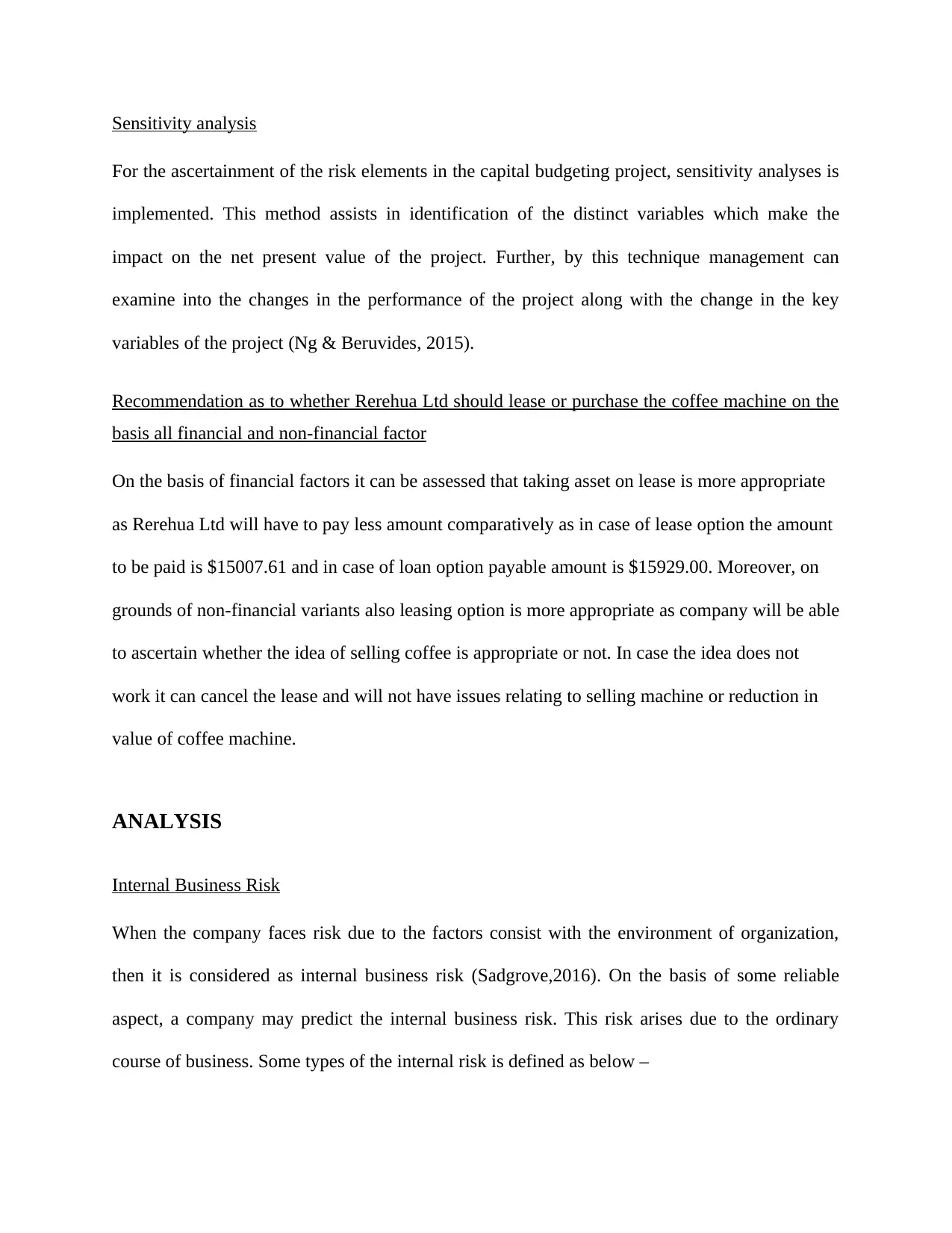
Sensitivity analysis
For the ascertainment of the risk elements in the capital budgeting project, sensitivity analyses is
implemented. This method assists in identification of the distinct variables which make the
impact on the net present value of the project. Further, by this technique management can
examine into the changes in the performance of the project along with the change in the key
variables of the project (Ng & Beruvides, 2015).
Recommendation as to whether Rerehua Ltd should lease or purchase the coffee machine on the
basis all financial and non-financial factor
On the basis of financial factors it can be assessed that taking asset on lease is more appropriate
as Rerehua Ltd will have to pay less amount comparatively as in case of lease option the amount
to be paid is $15007.61 and in case of loan option payable amount is $15929.00. Moreover, on
grounds of non-financial variants also leasing option is more appropriate as company will be able
to ascertain whether the idea of selling coffee is appropriate or not. In case the idea does not
work it can cancel the lease and will not have issues relating to selling machine or reduction in
value of coffee machine.
ANALYSIS
Internal Business Risk
When the company faces risk due to the factors consist with the environment of organization,
then it is considered as internal business risk (Sadgrove,2016). On the basis of some reliable
aspect, a company may predict the internal business risk. This risk arises due to the ordinary
course of business. Some types of the internal risk is defined as below –
For the ascertainment of the risk elements in the capital budgeting project, sensitivity analyses is
implemented. This method assists in identification of the distinct variables which make the
impact on the net present value of the project. Further, by this technique management can
examine into the changes in the performance of the project along with the change in the key
variables of the project (Ng & Beruvides, 2015).
Recommendation as to whether Rerehua Ltd should lease or purchase the coffee machine on the
basis all financial and non-financial factor
On the basis of financial factors it can be assessed that taking asset on lease is more appropriate
as Rerehua Ltd will have to pay less amount comparatively as in case of lease option the amount
to be paid is $15007.61 and in case of loan option payable amount is $15929.00. Moreover, on
grounds of non-financial variants also leasing option is more appropriate as company will be able
to ascertain whether the idea of selling coffee is appropriate or not. In case the idea does not
work it can cancel the lease and will not have issues relating to selling machine or reduction in
value of coffee machine.
ANALYSIS
Internal Business Risk
When the company faces risk due to the factors consist with the environment of organization,
then it is considered as internal business risk (Sadgrove,2016). On the basis of some reliable
aspect, a company may predict the internal business risk. This risk arises due to the ordinary
course of business. Some types of the internal risk is defined as below –
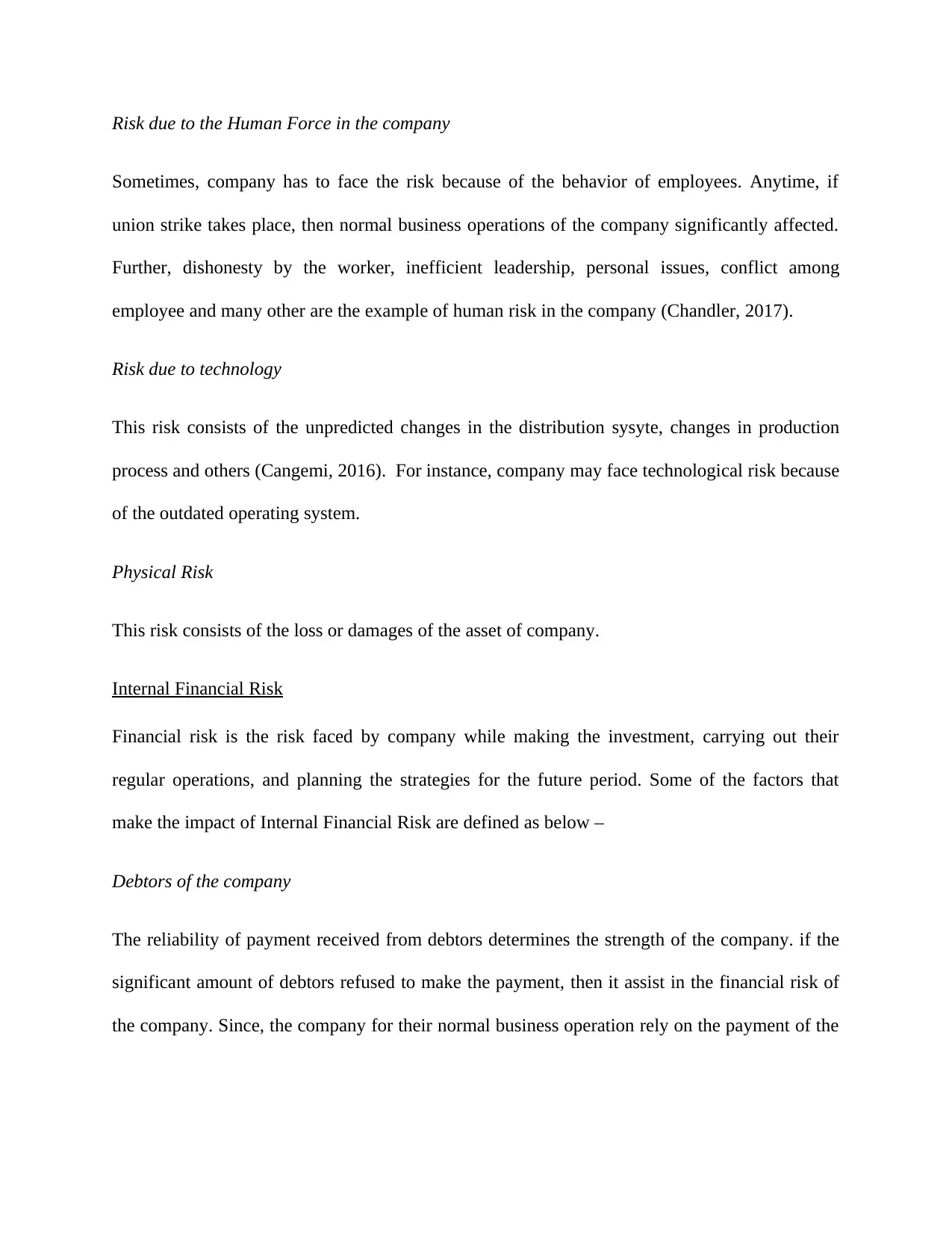
Risk due to the Human Force in the company
Sometimes, company has to face the risk because of the behavior of employees. Anytime, if
union strike takes place, then normal business operations of the company significantly affected.
Further, dishonesty by the worker, inefficient leadership, personal issues, conflict among
employee and many other are the example of human risk in the company (Chandler, 2017).
Risk due to technology
This risk consists of the unpredicted changes in the distribution sysyte, changes in production
process and others (Cangemi, 2016). For instance, company may face technological risk because
of the outdated operating system.
Physical Risk
This risk consists of the loss or damages of the asset of company.
Internal Financial Risk
Financial risk is the risk faced by company while making the investment, carrying out their
regular operations, and planning the strategies for the future period. Some of the factors that
make the impact of Internal Financial Risk are defined as below –
Debtors of the company
The reliability of payment received from debtors determines the strength of the company. if the
significant amount of debtors refused to make the payment, then it assist in the financial risk of
the company. Since, the company for their normal business operation rely on the payment of the
Sometimes, company has to face the risk because of the behavior of employees. Anytime, if
union strike takes place, then normal business operations of the company significantly affected.
Further, dishonesty by the worker, inefficient leadership, personal issues, conflict among
employee and many other are the example of human risk in the company (Chandler, 2017).
Risk due to technology
This risk consists of the unpredicted changes in the distribution sysyte, changes in production
process and others (Cangemi, 2016). For instance, company may face technological risk because
of the outdated operating system.
Physical Risk
This risk consists of the loss or damages of the asset of company.
Internal Financial Risk
Financial risk is the risk faced by company while making the investment, carrying out their
regular operations, and planning the strategies for the future period. Some of the factors that
make the impact of Internal Financial Risk are defined as below –
Debtors of the company
The reliability of payment received from debtors determines the strength of the company. if the
significant amount of debtors refused to make the payment, then it assist in the financial risk of
the company. Since, the company for their normal business operation rely on the payment of the
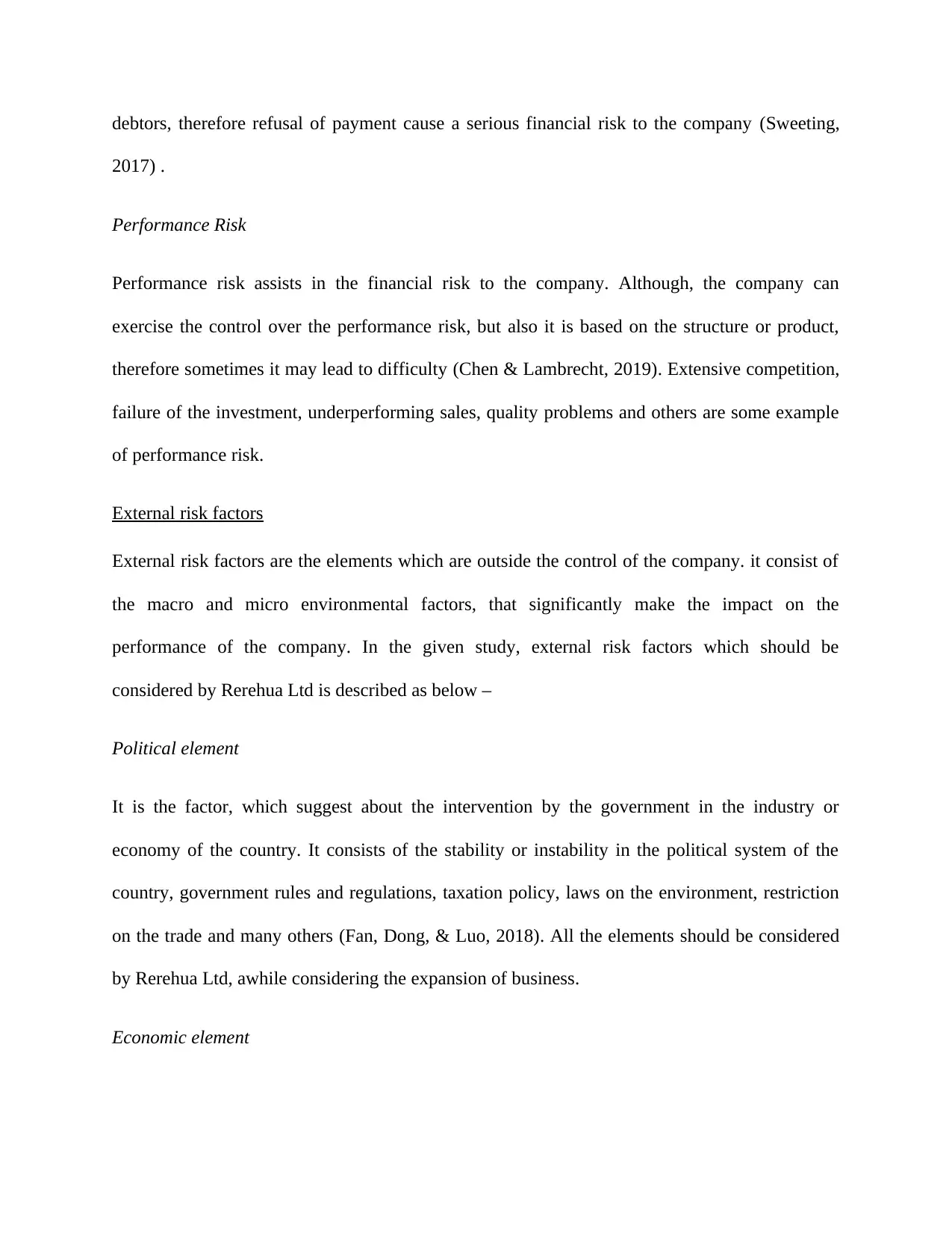
debtors, therefore refusal of payment cause a serious financial risk to the company (Sweeting,
2017) .
Performance Risk
Performance risk assists in the financial risk to the company. Although, the company can
exercise the control over the performance risk, but also it is based on the structure or product,
therefore sometimes it may lead to difficulty (Chen & Lambrecht, 2019). Extensive competition,
failure of the investment, underperforming sales, quality problems and others are some example
of performance risk.
External risk factors
External risk factors are the elements which are outside the control of the company. it consist of
the macro and micro environmental factors, that significantly make the impact on the
performance of the company. In the given study, external risk factors which should be
considered by Rerehua Ltd is described as below –
Political element
It is the factor, which suggest about the intervention by the government in the industry or
economy of the country. It consists of the stability or instability in the political system of the
country, government rules and regulations, taxation policy, laws on the environment, restriction
on the trade and many others (Fan, Dong, & Luo, 2018). All the elements should be considered
by Rerehua Ltd, awhile considering the expansion of business.
Economic element
2017) .
Performance Risk
Performance risk assists in the financial risk to the company. Although, the company can
exercise the control over the performance risk, but also it is based on the structure or product,
therefore sometimes it may lead to difficulty (Chen & Lambrecht, 2019). Extensive competition,
failure of the investment, underperforming sales, quality problems and others are some example
of performance risk.
External risk factors
External risk factors are the elements which are outside the control of the company. it consist of
the macro and micro environmental factors, that significantly make the impact on the
performance of the company. In the given study, external risk factors which should be
considered by Rerehua Ltd is described as below –
Political element
It is the factor, which suggest about the intervention by the government in the industry or
economy of the country. It consists of the stability or instability in the political system of the
country, government rules and regulations, taxation policy, laws on the environment, restriction
on the trade and many others (Fan, Dong, & Luo, 2018). All the elements should be considered
by Rerehua Ltd, awhile considering the expansion of business.
Economic element
Paraphrase This Document
Need a fresh take? Get an instant paraphrase of this document with our AI Paraphraser
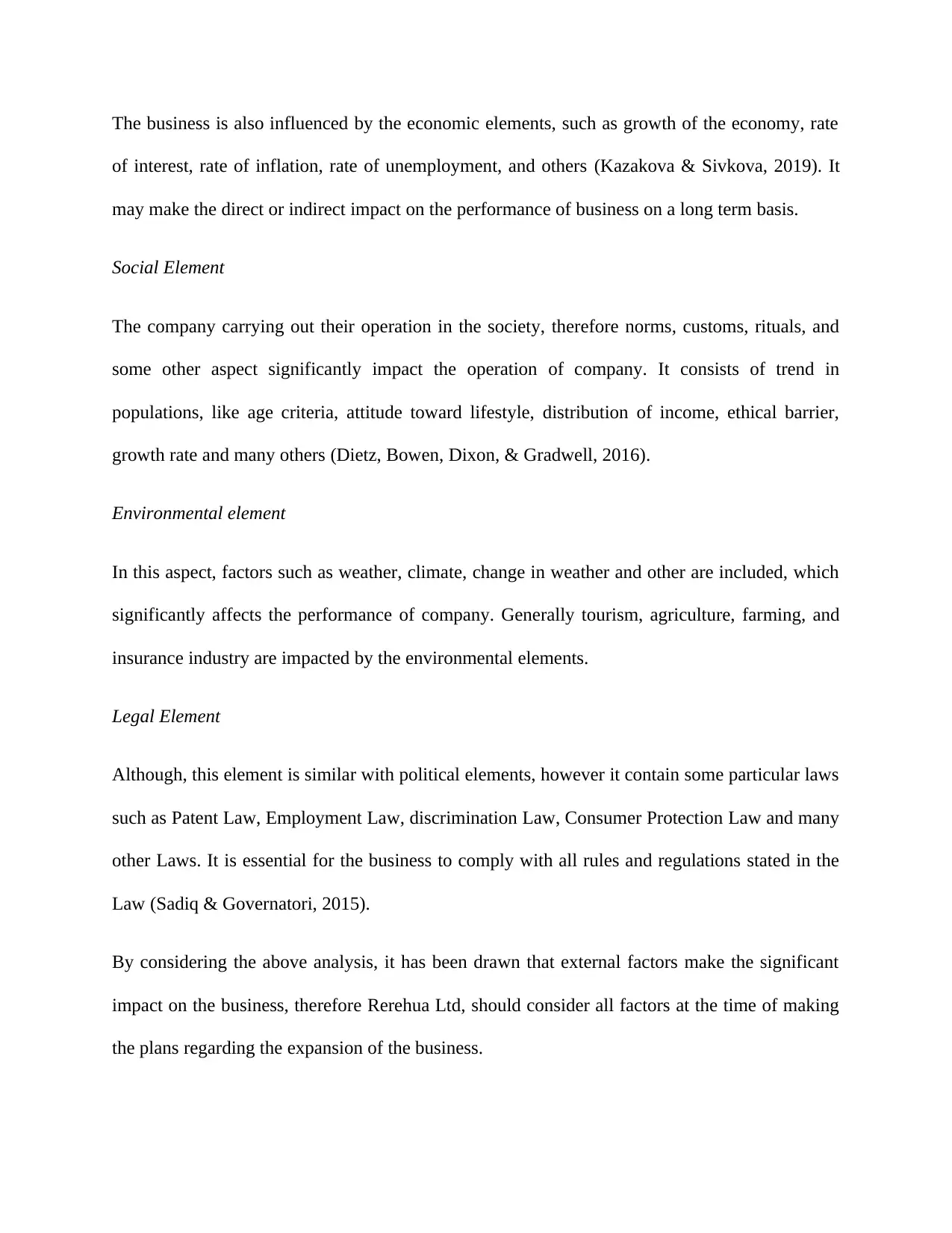
The business is also influenced by the economic elements, such as growth of the economy, rate
of interest, rate of inflation, rate of unemployment, and others (Kazakova & Sivkova, 2019). It
may make the direct or indirect impact on the performance of business on a long term basis.
Social Element
The company carrying out their operation in the society, therefore norms, customs, rituals, and
some other aspect significantly impact the operation of company. It consists of trend in
populations, like age criteria, attitude toward lifestyle, distribution of income, ethical barrier,
growth rate and many others (Dietz, Bowen, Dixon, & Gradwell, 2016).
Environmental element
In this aspect, factors such as weather, climate, change in weather and other are included, which
significantly affects the performance of company. Generally tourism, agriculture, farming, and
insurance industry are impacted by the environmental elements.
Legal Element
Although, this element is similar with political elements, however it contain some particular laws
such as Patent Law, Employment Law, discrimination Law, Consumer Protection Law and many
other Laws. It is essential for the business to comply with all rules and regulations stated in the
Law (Sadiq & Governatori, 2015).
By considering the above analysis, it has been drawn that external factors make the significant
impact on the business, therefore Rerehua Ltd, should consider all factors at the time of making
the plans regarding the expansion of the business.
of interest, rate of inflation, rate of unemployment, and others (Kazakova & Sivkova, 2019). It
may make the direct or indirect impact on the performance of business on a long term basis.
Social Element
The company carrying out their operation in the society, therefore norms, customs, rituals, and
some other aspect significantly impact the operation of company. It consists of trend in
populations, like age criteria, attitude toward lifestyle, distribution of income, ethical barrier,
growth rate and many others (Dietz, Bowen, Dixon, & Gradwell, 2016).
Environmental element
In this aspect, factors such as weather, climate, change in weather and other are included, which
significantly affects the performance of company. Generally tourism, agriculture, farming, and
insurance industry are impacted by the environmental elements.
Legal Element
Although, this element is similar with political elements, however it contain some particular laws
such as Patent Law, Employment Law, discrimination Law, Consumer Protection Law and many
other Laws. It is essential for the business to comply with all rules and regulations stated in the
Law (Sadiq & Governatori, 2015).
By considering the above analysis, it has been drawn that external factors make the significant
impact on the business, therefore Rerehua Ltd, should consider all factors at the time of making
the plans regarding the expansion of the business.
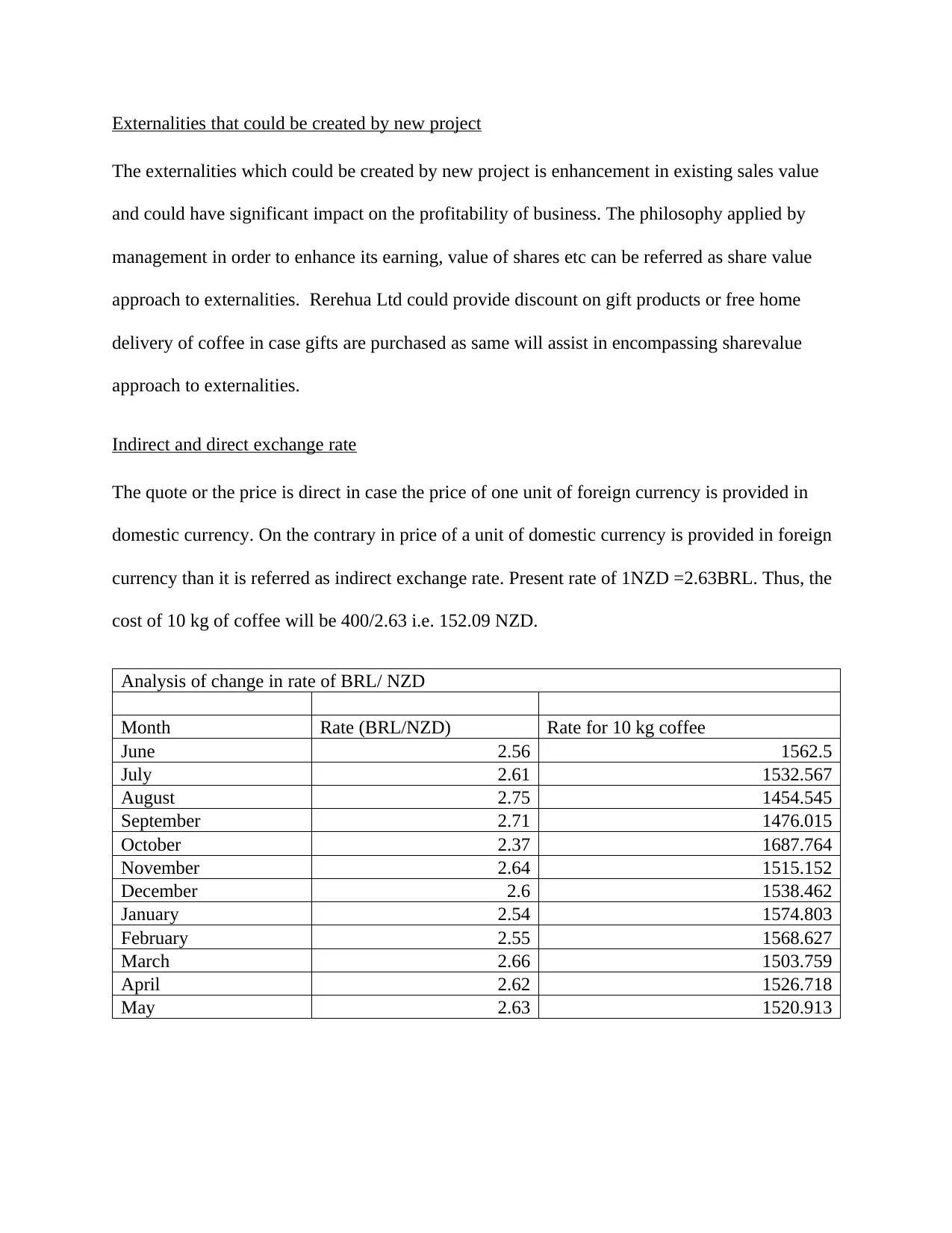
Externalities that could be created by new project
The externalities which could be created by new project is enhancement in existing sales value
and could have significant impact on the profitability of business. The philosophy applied by
management in order to enhance its earning, value of shares etc can be referred as share value
approach to externalities. Rerehua Ltd could provide discount on gift products or free home
delivery of coffee in case gifts are purchased as same will assist in encompassing sharevalue
approach to externalities.
Indirect and direct exchange rate
The quote or the price is direct in case the price of one unit of foreign currency is provided in
domestic currency. On the contrary in price of a unit of domestic currency is provided in foreign
currency than it is referred as indirect exchange rate. Present rate of 1NZD =2.63BRL. Thus, the
cost of 10 kg of coffee will be 400/2.63 i.e. 152.09 NZD.
Analysis of change in rate of BRL/ NZD
Month Rate (BRL/NZD) Rate for 10 kg coffee
June 2.56 1562.5
July 2.61 1532.567
August 2.75 1454.545
September 2.71 1476.015
October 2.37 1687.764
November 2.64 1515.152
December 2.6 1538.462
January 2.54 1574.803
February 2.55 1568.627
March 2.66 1503.759
April 2.62 1526.718
May 2.63 1520.913
The externalities which could be created by new project is enhancement in existing sales value
and could have significant impact on the profitability of business. The philosophy applied by
management in order to enhance its earning, value of shares etc can be referred as share value
approach to externalities. Rerehua Ltd could provide discount on gift products or free home
delivery of coffee in case gifts are purchased as same will assist in encompassing sharevalue
approach to externalities.
Indirect and direct exchange rate
The quote or the price is direct in case the price of one unit of foreign currency is provided in
domestic currency. On the contrary in price of a unit of domestic currency is provided in foreign
currency than it is referred as indirect exchange rate. Present rate of 1NZD =2.63BRL. Thus, the
cost of 10 kg of coffee will be 400/2.63 i.e. 152.09 NZD.
Analysis of change in rate of BRL/ NZD
Month Rate (BRL/NZD) Rate for 10 kg coffee
June 2.56 1562.5
July 2.61 1532.567
August 2.75 1454.545
September 2.71 1476.015
October 2.37 1687.764
November 2.64 1515.152
December 2.6 1538.462
January 2.54 1574.803
February 2.55 1568.627
March 2.66 1503.759
April 2.62 1526.718
May 2.63 1520.913
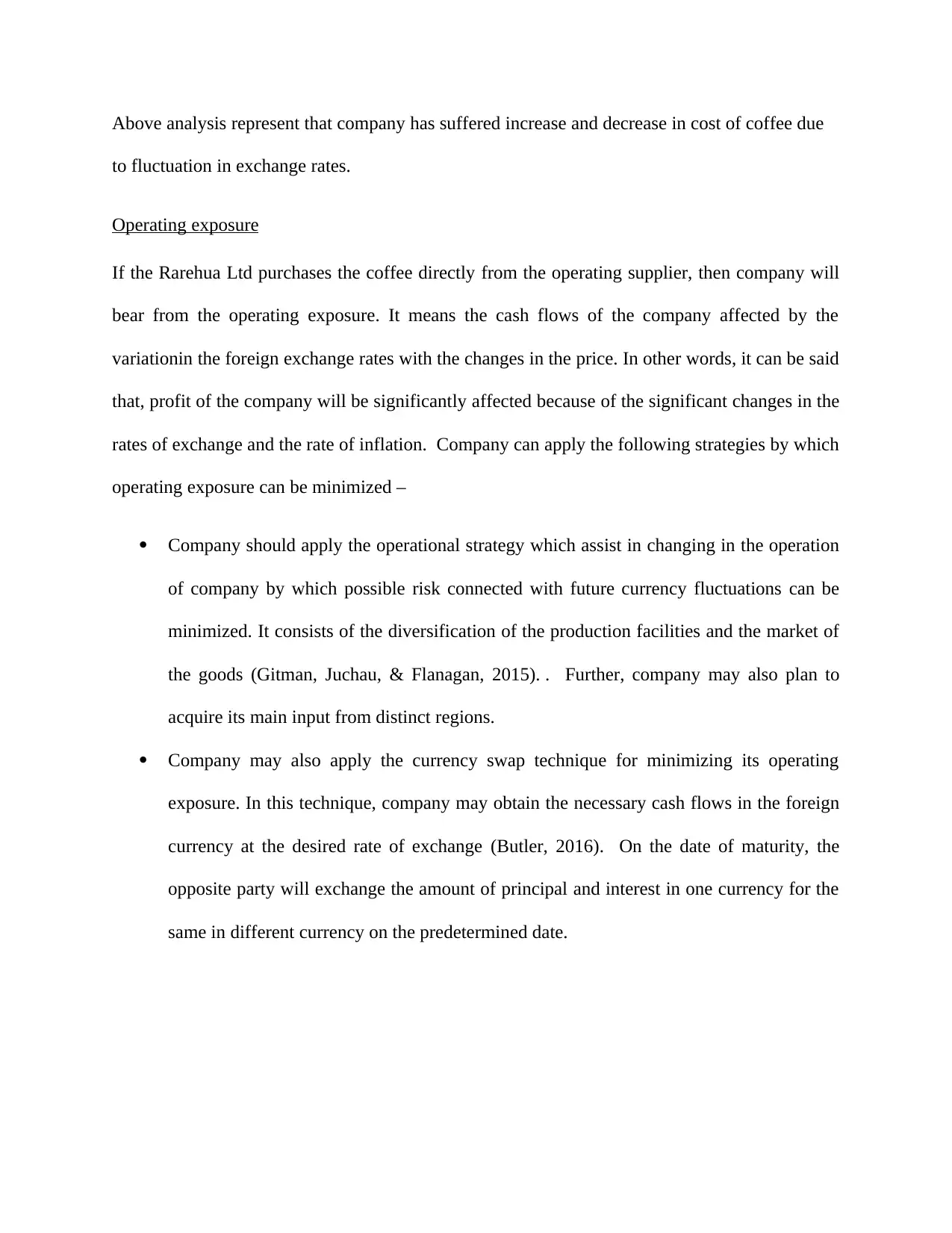
Above analysis represent that company has suffered increase and decrease in cost of coffee due
to fluctuation in exchange rates.
Operating exposure
If the Rarehua Ltd purchases the coffee directly from the operating supplier, then company will
bear from the operating exposure. It means the cash flows of the company affected by the
variationin the foreign exchange rates with the changes in the price. In other words, it can be said
that, profit of the company will be significantly affected because of the significant changes in the
rates of exchange and the rate of inflation. Company can apply the following strategies by which
operating exposure can be minimized –
Company should apply the operational strategy which assist in changing in the operation
of company by which possible risk connected with future currency fluctuations can be
minimized. It consists of the diversification of the production facilities and the market of
the goods (Gitman, Juchau, & Flanagan, 2015). . Further, company may also plan to
acquire its main input from distinct regions.
Company may also apply the currency swap technique for minimizing its operating
exposure. In this technique, company may obtain the necessary cash flows in the foreign
currency at the desired rate of exchange (Butler, 2016). On the date of maturity, the
opposite party will exchange the amount of principal and interest in one currency for the
same in different currency on the predetermined date.
to fluctuation in exchange rates.
Operating exposure
If the Rarehua Ltd purchases the coffee directly from the operating supplier, then company will
bear from the operating exposure. It means the cash flows of the company affected by the
variationin the foreign exchange rates with the changes in the price. In other words, it can be said
that, profit of the company will be significantly affected because of the significant changes in the
rates of exchange and the rate of inflation. Company can apply the following strategies by which
operating exposure can be minimized –
Company should apply the operational strategy which assist in changing in the operation
of company by which possible risk connected with future currency fluctuations can be
minimized. It consists of the diversification of the production facilities and the market of
the goods (Gitman, Juchau, & Flanagan, 2015). . Further, company may also plan to
acquire its main input from distinct regions.
Company may also apply the currency swap technique for minimizing its operating
exposure. In this technique, company may obtain the necessary cash flows in the foreign
currency at the desired rate of exchange (Butler, 2016). On the date of maturity, the
opposite party will exchange the amount of principal and interest in one currency for the
same in different currency on the predetermined date.
Secure Best Marks with AI Grader
Need help grading? Try our AI Grader for instant feedback on your assignments.
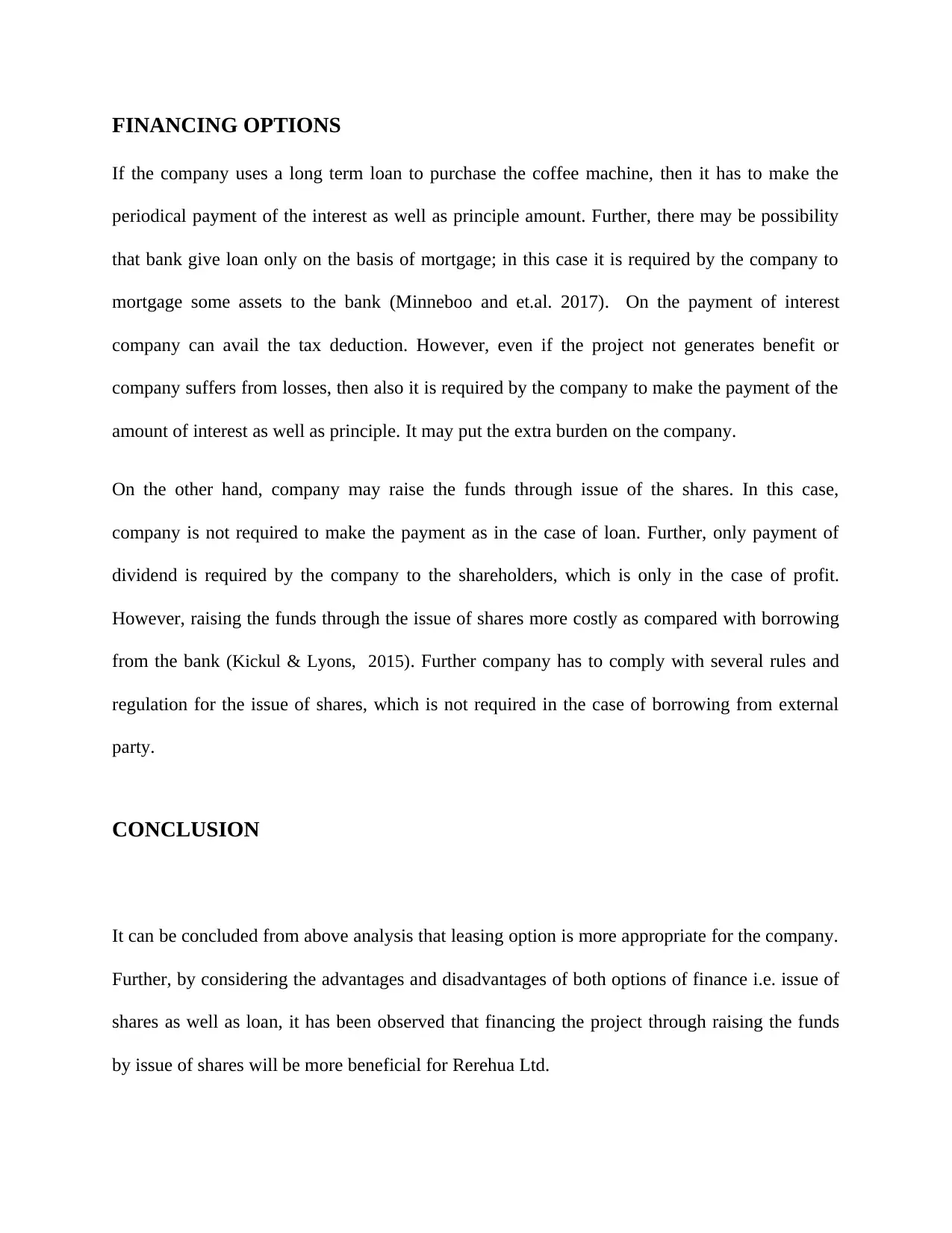
FINANCING OPTIONS
If the company uses a long term loan to purchase the coffee machine, then it has to make the
periodical payment of the interest as well as principle amount. Further, there may be possibility
that bank give loan only on the basis of mortgage; in this case it is required by the company to
mortgage some assets to the bank (Minneboo and et.al. 2017). On the payment of interest
company can avail the tax deduction. However, even if the project not generates benefit or
company suffers from losses, then also it is required by the company to make the payment of the
amount of interest as well as principle. It may put the extra burden on the company.
On the other hand, company may raise the funds through issue of the shares. In this case,
company is not required to make the payment as in the case of loan. Further, only payment of
dividend is required by the company to the shareholders, which is only in the case of profit.
However, raising the funds through the issue of shares more costly as compared with borrowing
from the bank (Kickul & Lyons, 2015). Further company has to comply with several rules and
regulation for the issue of shares, which is not required in the case of borrowing from external
party.
CONCLUSION
It can be concluded from above analysis that leasing option is more appropriate for the company.
Further, by considering the advantages and disadvantages of both options of finance i.e. issue of
shares as well as loan, it has been observed that financing the project through raising the funds
by issue of shares will be more beneficial for Rerehua Ltd.
If the company uses a long term loan to purchase the coffee machine, then it has to make the
periodical payment of the interest as well as principle amount. Further, there may be possibility
that bank give loan only on the basis of mortgage; in this case it is required by the company to
mortgage some assets to the bank (Minneboo and et.al. 2017). On the payment of interest
company can avail the tax deduction. However, even if the project not generates benefit or
company suffers from losses, then also it is required by the company to make the payment of the
amount of interest as well as principle. It may put the extra burden on the company.
On the other hand, company may raise the funds through issue of the shares. In this case,
company is not required to make the payment as in the case of loan. Further, only payment of
dividend is required by the company to the shareholders, which is only in the case of profit.
However, raising the funds through the issue of shares more costly as compared with borrowing
from the bank (Kickul & Lyons, 2015). Further company has to comply with several rules and
regulation for the issue of shares, which is not required in the case of borrowing from external
party.
CONCLUSION
It can be concluded from above analysis that leasing option is more appropriate for the company.
Further, by considering the advantages and disadvantages of both options of finance i.e. issue of
shares as well as loan, it has been observed that financing the project through raising the funds
by issue of shares will be more beneficial for Rerehua Ltd.
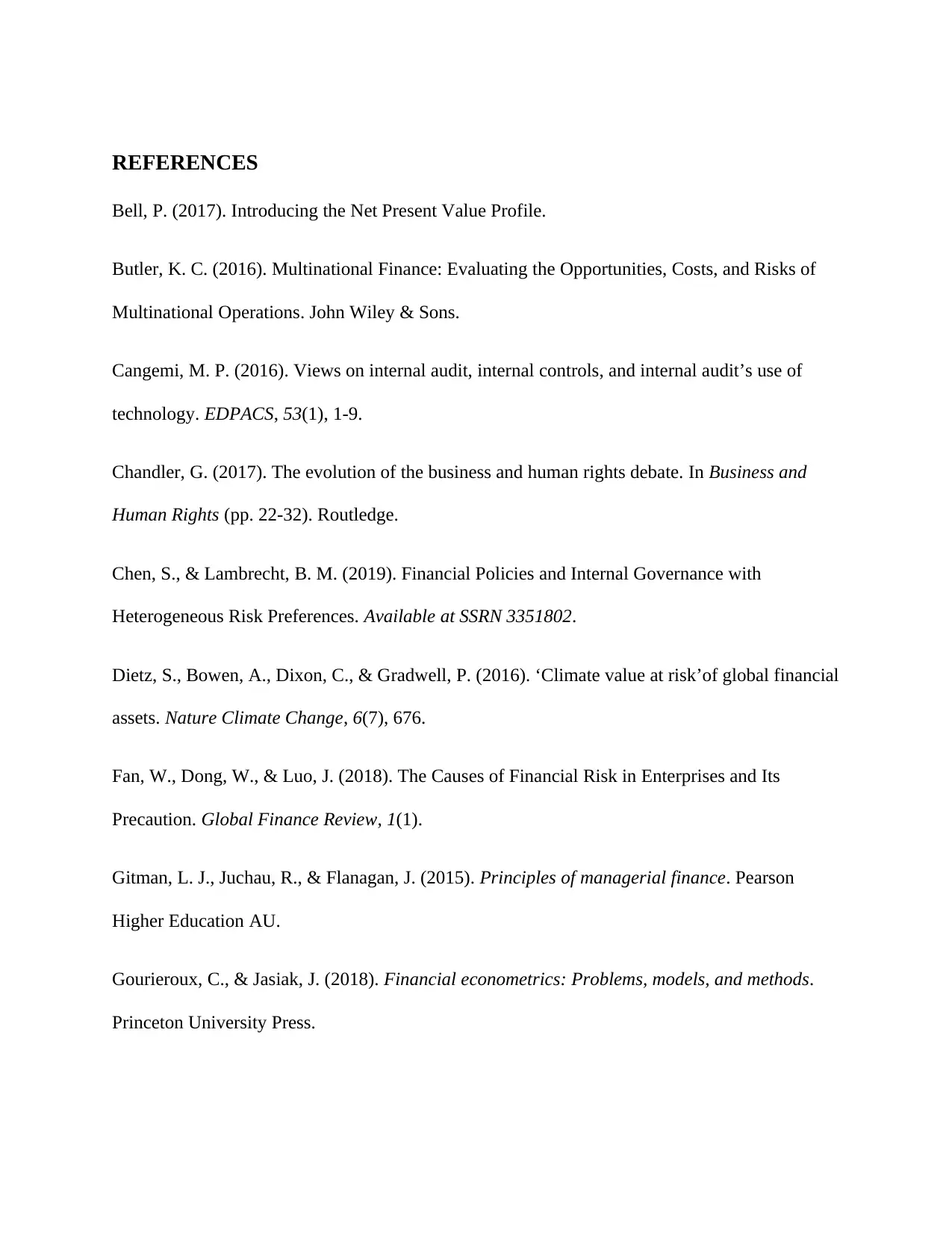
REFERENCES
Bell, P. (2017). Introducing the Net Present Value Profile.
Butler, K. C. (2016). Multinational Finance: Evaluating the Opportunities, Costs, and Risks of
Multinational Operations. John Wiley & Sons.
Cangemi, M. P. (2016). Views on internal audit, internal controls, and internal audit’s use of
technology. EDPACS, 53(1), 1-9.
Chandler, G. (2017). The evolution of the business and human rights debate. In Business and
Human Rights (pp. 22-32). Routledge.
Chen, S., & Lambrecht, B. M. (2019). Financial Policies and Internal Governance with
Heterogeneous Risk Preferences. Available at SSRN 3351802.
Dietz, S., Bowen, A., Dixon, C., & Gradwell, P. (2016). ‘Climate value at risk’of global financial
assets. Nature Climate Change, 6(7), 676.
Fan, W., Dong, W., & Luo, J. (2018). The Causes of Financial Risk in Enterprises and Its
Precaution. Global Finance Review, 1(1).
Gitman, L. J., Juchau, R., & Flanagan, J. (2015). Principles of managerial finance. Pearson
Higher Education AU.
Gourieroux, C., & Jasiak, J. (2018). Financial econometrics: Problems, models, and methods.
Princeton University Press.
Bell, P. (2017). Introducing the Net Present Value Profile.
Butler, K. C. (2016). Multinational Finance: Evaluating the Opportunities, Costs, and Risks of
Multinational Operations. John Wiley & Sons.
Cangemi, M. P. (2016). Views on internal audit, internal controls, and internal audit’s use of
technology. EDPACS, 53(1), 1-9.
Chandler, G. (2017). The evolution of the business and human rights debate. In Business and
Human Rights (pp. 22-32). Routledge.
Chen, S., & Lambrecht, B. M. (2019). Financial Policies and Internal Governance with
Heterogeneous Risk Preferences. Available at SSRN 3351802.
Dietz, S., Bowen, A., Dixon, C., & Gradwell, P. (2016). ‘Climate value at risk’of global financial
assets. Nature Climate Change, 6(7), 676.
Fan, W., Dong, W., & Luo, J. (2018). The Causes of Financial Risk in Enterprises and Its
Precaution. Global Finance Review, 1(1).
Gitman, L. J., Juchau, R., & Flanagan, J. (2015). Principles of managerial finance. Pearson
Higher Education AU.
Gourieroux, C., & Jasiak, J. (2018). Financial econometrics: Problems, models, and methods.
Princeton University Press.
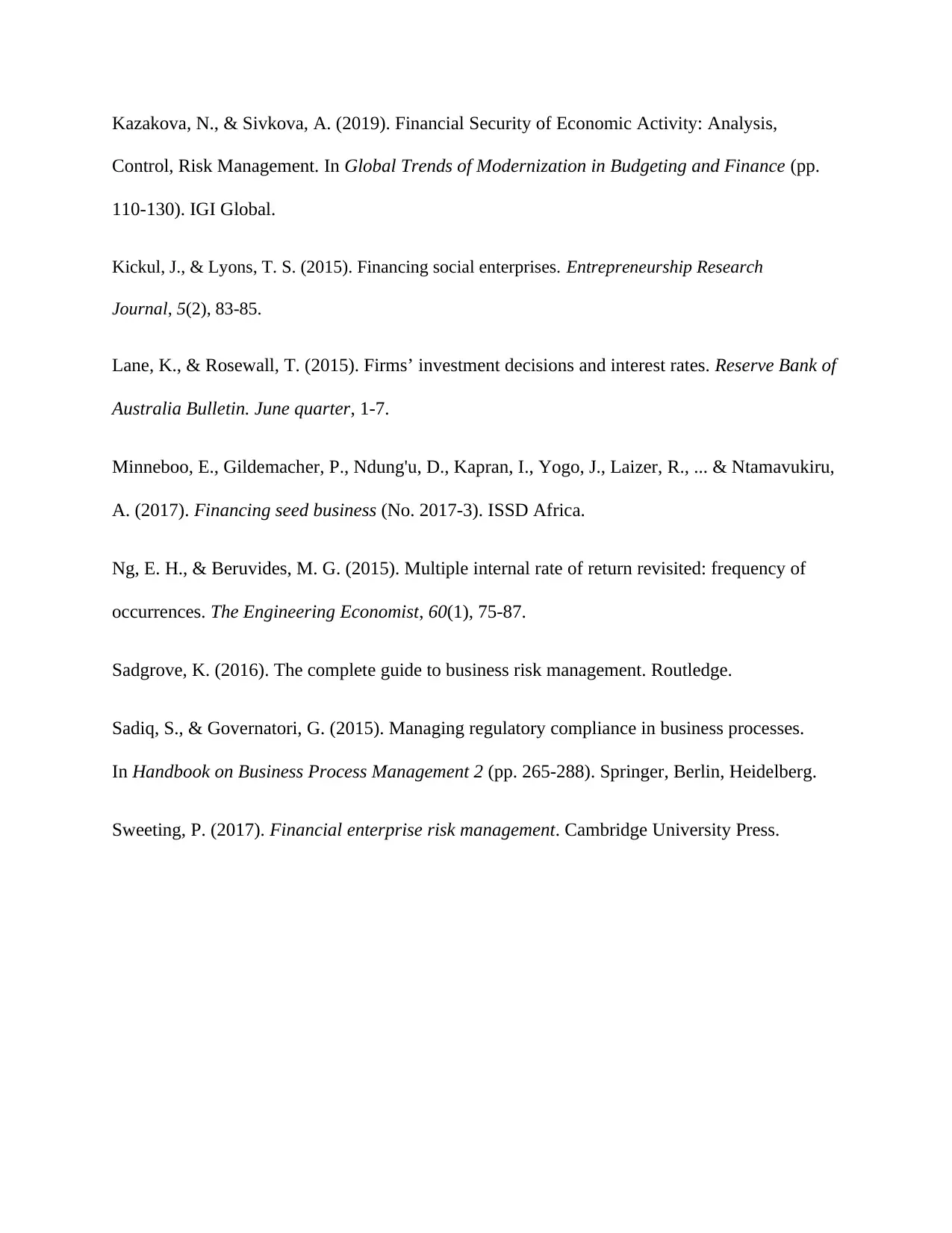
Kazakova, N., & Sivkova, A. (2019). Financial Security of Economic Activity: Analysis,
Control, Risk Management. In Global Trends of Modernization in Budgeting and Finance (pp.
110-130). IGI Global.
Kickul, J., & Lyons, T. S. (2015). Financing social enterprises. Entrepreneurship Research
Journal, 5(2), 83-85.
Lane, K., & Rosewall, T. (2015). Firms’ investment decisions and interest rates. Reserve Bank of
Australia Bulletin. June quarter, 1-7.
Minneboo, E., Gildemacher, P., Ndung'u, D., Kapran, I., Yogo, J., Laizer, R., ... & Ntamavukiru,
A. (2017). Financing seed business (No. 2017-3). ISSD Africa.
Ng, E. H., & Beruvides, M. G. (2015). Multiple internal rate of return revisited: frequency of
occurrences. The Engineering Economist, 60(1), 75-87.
Sadgrove, K. (2016). The complete guide to business risk management. Routledge.
Sadiq, S., & Governatori, G. (2015). Managing regulatory compliance in business processes.
In Handbook on Business Process Management 2 (pp. 265-288). Springer, Berlin, Heidelberg.
Sweeting, P. (2017). Financial enterprise risk management. Cambridge University Press.
Control, Risk Management. In Global Trends of Modernization in Budgeting and Finance (pp.
110-130). IGI Global.
Kickul, J., & Lyons, T. S. (2015). Financing social enterprises. Entrepreneurship Research
Journal, 5(2), 83-85.
Lane, K., & Rosewall, T. (2015). Firms’ investment decisions and interest rates. Reserve Bank of
Australia Bulletin. June quarter, 1-7.
Minneboo, E., Gildemacher, P., Ndung'u, D., Kapran, I., Yogo, J., Laizer, R., ... & Ntamavukiru,
A. (2017). Financing seed business (No. 2017-3). ISSD Africa.
Ng, E. H., & Beruvides, M. G. (2015). Multiple internal rate of return revisited: frequency of
occurrences. The Engineering Economist, 60(1), 75-87.
Sadgrove, K. (2016). The complete guide to business risk management. Routledge.
Sadiq, S., & Governatori, G. (2015). Managing regulatory compliance in business processes.
In Handbook on Business Process Management 2 (pp. 265-288). Springer, Berlin, Heidelberg.
Sweeting, P. (2017). Financial enterprise risk management. Cambridge University Press.
1 out of 19
Related Documents
Your All-in-One AI-Powered Toolkit for Academic Success.
+13062052269
info@desklib.com
Available 24*7 on WhatsApp / Email
![[object Object]](/_next/static/media/star-bottom.7253800d.svg)
Unlock your academic potential
© 2024 | Zucol Services PVT LTD | All rights reserved.





